#also god there are so many interesting permutations you could make with this
Explore tagged Tumblr posts
Text
Alright, final results when you exclude the votes for confused and see results, and then add up the overlapping categories (i.e. to see what percent of people would pull the lever if they were chooser B, I added up the number of votes for "only if I were chooser b", "if i were B, C, D, E", and "if i were any chooser", then divided by 203 (the number of voters left after removing confused and uncaring voters)).
The percent of people who would pull the lever if they were Chooser A is 12.81%.
For Chooser B, it's 10.84%.
For Chooser C it's 15.27%.
For Chooser D it's 33%.
And for Chooser E it's also 33%.
8.87% of people said they would always pull the lever, and 51.23% of people said they would never pull the lever (so 48.77% said they would pull it in some position.)
All in all, the results are...actually about what I expected. The only thing that really surprised me at all is the number of people who would never pull it, since its probably safe to assume that a good number of people who actually wouldnt pull it ever would still say that they would. The fact that A got slightly higher votes than B doesnt surprise me, but it Is still interesting.
I do wonder whether, if the sample size were much larger, D would have been slightly higher than E, since from a mathematical perspective it's on average slightly worse, or if thats just not an important distinction for anyone to make.
But also this is a tumblr poll with a very small sample size, so these numbers are basically meaningless. Still fun though.
Yet another dumb Trolley Problem (fixed) :)
Plz read all the options before voting.
(Clarification: the green people are only the friends of that chooser, but are always there. For example, the three green people on the 2nd track are friends with only Chooser B; they are strangers to all of the other Choosers.
Also Clarification: All people in the image are always there. This means all the Choosers are always there. If you are, for example, Chooser C, then all of the other Choosers are still in their positions, and are strangers to you. Choosers cannot communicate with each other.)

#polls#trolley problem#moral philosophy#i am finishes being annoying for now :)#also god there are so many interesting permutations you could make with this#but im probably not going to#at least not any time soon#posts taking place entirely up my own asshole
97 notes
·
View notes
Text
Fraymotif Introductory Megapost
Wow, cool, an intro post.
This is a Homestuck blog, with a lot of spoilers. A LOT.
This is your warning.
So what’s this all about?
Fraymotifs are powerful battle techniques used by Sburb's Heroes. They are basically super god-like combo attacks between multiple Heroes of differing aspects. In canon, they are shown to be 2 to 3 player combos, but it is theorized that they can include up to 12 players.
Interactions between Classpects
The way I look at Fraymotifs is as a synergy between synergies. A Hero’s Class is how they interact with their own Aspect, while a Fraymotif is how two or more Heroes interact with each other’s Classpects (Jade, a Witch of Space, changing the space in which Dave’s, a Knight of Time, protection through time is used into a single concentrated bubble; slowing time within a bubble around Bec Noir via Adagio Redshift).
My Goal with this very ambitious blog
There are 144 unique Mythological Roles (Classpects) within Sburb, and a Fraymotif involves 2+ of them. Let’s do the math for a second. The equation to figure out the number of combinations there are between r elements of a set of n items, ignoring differing permutations, is: C(n,r)=n!/(r!(n−r)!). So, 144 choose 2 comes out to be 10,296. That's actually 10 thousand different Fraymotifs for just combos of two Heroes. It shoots up to 400k+ once you include combinations of 3. There’s probably a lot less when you disclude combos between Heroes of the same Aspect, but its still an astronomical number. On top of that, there are at LEAST 36 single-Aspect Fraymotifs, meant to be used by a single Hero, and I do not wish to cover those, simply as a personal preference for what I find interesting. Sorry, I’ve got enough on my plate with the 10k+ I already intend to do, and those are at least wacky goofy combos.
I wish to at least cover what I think ALL 2-Player Fraymotifs there can be, in this blog. That is over ten thousand, so I will be covering many at a time within a post. There also may be more than one possible Fraymotif per Aspect-Combo, but for the sake of brevity (the irony is not lost on me) I will limit it such that each Pair of Classpects only get 1 Fraymotif assigned to them. That narrows it down to a measly 9504, and I do not feel sorry for making each of them special.
I don’t know if I will have the brainpower to cover 3+ Player Fraymotifs as thoroughly, so I will only cover them upon request! So please ask if you really wish for my take! I will be glad to nerd out some more. Hell, you can ask pretty much anything you want about my efforts, that's what the askbox is for (^-^)b
The Fraymotif design process
This will develop the longer I run this blog, but as it stands now, I start by analyzing the Classpects of each Hero involved and take note of their abilities in their own right. Witch of Space naturally has control over the properties of physical Space so their abilities could localize and/or expand the area of effect of other physical powers, stuff like that. Of course, this requires a comprehensive understanding of Classpecting first. Classpecting as a magic system is defined in-world by flawed/biased narrators, so most of it is left up to interpretation. As a Mage of Heart myself, I am very Classpecting-pilled, and I feel as though I grasp the concept very naturally. For areas in which my understanding is a bit thin, I do like to reference Ouroborista’s take on the system, and I am especially fond of the Class symmetry proposed therein, albeit a bit contested throughout the community. But hey, most of it is up to interpretation anyway, so if you disagree, please let me know in the asks, I would love to hear your opinions! Classpecting is all symbology lol.
Next I look at how the abilities of the Heroes interact with each other, obviously. A Witch of Space localizes the time powers of a Knight of Time, and constructively interferes with the powers’ purpose of protecting, keeping the Target trapped in a bubble separated from the outside world (Adagio Redshift). A Seer of Mind may use the Knight of Time’s protection as a guide to see through the various alternate outcomes to find a version of events where things went a little better, and the Knight would then lock-on to that timeline to bring their partner to refuge, perhaps re-doing a section they struggled on before (Assylum Dal Segno). It is mostly a case-by-case basis, but a HUGE part of Fraymotifs are the Motifs themselves, that is to say, a theme or recurring element. The motive behind a power or ability. A Knight of Time would have access to Time shenanigans (That’s the theme of their powers), but the leading motive behind them will be for Protection, even though they are a solid combatant by themselves.
Edit: I forgot to mention that while non-godtiers are able to use Fraymotifs (See: Dave and Terezi with Assylum Dal Segno in [S] Collide), I will be designing these under the assumption that all participants are godtier. Some Fraymotifs will be simple, despite everyone's access to their full godtier kit, but seriously there's 9.5k of them they can't all be perfect.
There are obviously a few Fraymotifs that are defined in canon. But I mean. Come on. Canon is a tangible thing that can be messed with in Homestuck, and mess with it I shall. There are 11 2-Player Fraymotifs that we see in HS, and when you treat June and Rose’s and Dave and Terezi’s duplicates as a single Fraymotif each (as I will because they are consistent in how they utilize the abilities despite a different graphic (well, except for Rose and Roxy but that’s a whole different beast I will address in the next section)), that lowers it down to 7-technically-8 Fraymotifs that have been shown, and only 4 of those are named. I will try to keep-in-line with the Fraymotifs we actually do see, and interpret them in a way that matches the tone with the rest of the ones I design, because its 7-technically-8 out of 9.5 thousand, and I don’t see you out here doing this.
Following that is the fun part -- the name. Fraymotifs are music-themed, and thus have music-themed name schemes. Ivories in the Fire (Heir of Breath + Knight of Time), Mixolydian Maelstrom (Heir of Breath + Seer of Light), Fantasia's Inhale (Heir of Breath + Witch of Space), and Adagio Redshift (Witch of Space + Knight of Time), to name a few (that’s actually all of the named ones in-world). So keeping with that theme, I will come up with equally badass and/or ethereal names for the other 9.5k. Such as: Assylum Dal Segno (Knight of Time + Seer of Mind), Sostenuto Spotlight (Knight of Light + Mage of Heart), Flash Sforzando (Page of Light + Mage of Heart), etc.
Preemptively addressing my personal biases
Hussie outright stated that before the events of [S] Collide, Fraymotifs were a piece of throwaway worldbuilding, and are referenced as a hard magic system, despite the fact that it is anything but. This frustrates me to my core, like, fricking, for example: Both of June and Rose’s Fraymotifs shown in [S] Collide can be interpreted as the aforementioned Mixolydian Maelstrom, which is just varying forms of attacking with wind and lasers. And Dave and Terezi’s (Assylum Dal Segno) can both be interpreted as allowing a Target refuge in another, better timeline, because they both either bring Dirk back or send themselves to another timeline and both are actually part of the same series of events. So that’s all fine. But. The Lalondes. Rose and Roxy have two separate Fraymotifs together, one where Roxy does a Voidey thing and removes the nonexistence of a bunch of perfectly generic objects in a laser-cube made by Rose, and another where they just do a bunch of Aspect-related attacks.
In fact, a lot of Rose’s powers seem to just be “lighty magic attack:” when that is far from her role as a Seer, and goes against that whole “leading motive” theme I brought up earlier. It seems that she was just around to do laser stuff. Which is cool! In a fast-paced epic fight sequence! I liked it! But I want to get a bit more creative with these, moving past the “they hit them a lot with their Aspect” for those Classpects where they can do so much more than that. I said that canon was something to be messed with, and I’m going to tweak things as I see necessary because there are 7-technically-8 that are shown out of the 9.5 thousand I’m going to do so who cares.
Another thing I want to bring up goes more into the Classpecting side of Fraymotif design. In the 12 Aspects, they are aligned along the Time-Space axis, but something that I rarely see focused on is the Breath-Blood axis. Time and Space rule the physical world, but Breath and Blood rule the nonphysical world in a way I find really cool and interesting. I see Breath and Blood operating not only under their commonly understood Freedom/Bonds mechanics, but also messing around with causality. I think that Blood is very fate/destiny-coded and that Breath is very unrestricted from such matters. Karkat and Kankri both had a personal arc based around the fate/destiny of their people, and feeling responsible for it when all that got messed up, while Tavros and Rufioh both had a personal arc about becoming detached from who they were “supposed to be”, June especially becoming fully detached from deterministic causality with her retcon powers being able to mess with past events without dooming the timeline (and her being removed from who she was due to that broblorone making her transfem). You may be thinking “Oh, but Doom is for outcomes and fate” but really only with destruction and bad endings. Hope and Rage deal with positive/negative emotion but Heart does ALL emotion indiscriminately. When chopping up the whole universe into just 12 pieces (13 if you count Piss. (I do not count Piss.)), there’s going to be some overlap on account of there being more than 12 Things in the universe. Them’s the breaks.
Last thing here is the names. A lot of people, and I mean a LOT of people, look at Hero-specific names as being taken from a pool of words that have to deal with their Aspect. Like, a lot of people will interpret the name Ivories in the Fire (Heir of Breath + Knight of Time) as having the components "Ivories" + "in the Fire", where "Ivories" is a "Breathy word" and "in the Fire" is a "Timey word" and will just toss them around until there are like 50 "X in the Fire" Fraymotifs. I'm not a huge fan of that. Another way this is seen is in Land names, where people will read "Land of Maps and Treasure" and will automatically throw in "Maps" into a big grab-bag of Light words and "Treasure" into a separate bag of Thief words, as if this was a cheap flash name generator instead of a deeply specific thematic choice. Perhaps I'm being melodramatic (very real chance there), but I think that each name should be about what the Fraymotif does more than what it's made of. "Redshift" isnt specifically a Space word or a Time word, it's a phenomenon that is deeply tied to both Space and Time, and Adagio is a reference to the time-slowing effect of the Fraymotif. Obviously, with 9.5 thousand to come up with, there will be a lot of names that are similar, but they'll be on a case-by-case basis.
How in the world will I go about posting all of this?
There’s over ten thousand of these damn things, so I will come up with a whole bunch in one go, and make that one post, tagged appropriately ofc. These posts will be queued, so there will be at most 1 per day, and any asks will be answered as soon as I get them, skipping the queue (unless your request is in the queue, then you gotta wait :p).
There will be many Fraymotifs per post on some posts, like 15+ 12 max, so there will be at least 1.7-ish 2 years before this blog is full-up on Fraymotifs. Wack.
Edit: fixed the stats
Alright, thanks for reading, again please ask anything in the askbox, and I hope you enjoy my handiwork B)
12 notes
·
View notes
Text
Okay I’m starting a new series on here called “I just finished this game” where I gush about a game I just finished.
Anyway, if you’re a fan of musicals, visual novels, or Greek mythology, you NEED to play Stray Gods.
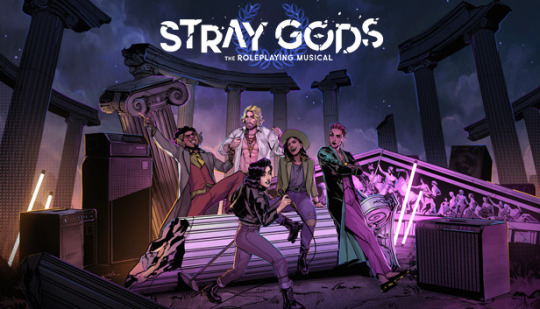
If you haven’t heard of it before, Stray Gods is a visual novel with branching story routes, but it has the twist of also being a musical! Many of the game’s major choices take place in the songs themselves, and the songs will actually changed based on your decisions! Each song has numerous different permutations based on around 3-5 choices in each one. I recommend checking out Challenging a Queen, one of the early game songs that’s relatively light on spoilers, to see how some of the choices really add some spice to the game and weave through the songs.
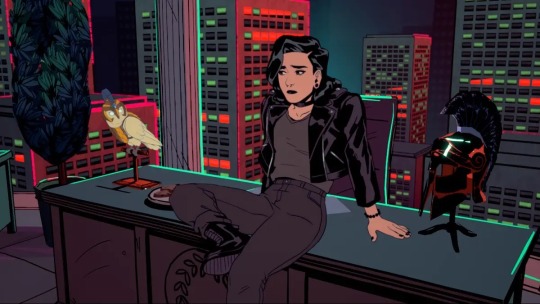
The game’s story just follows Grace, a 20-something girl who witnesses the death of Calliope, the Last Muse, and to make matters worse, she has inherited her powers and role. The Chorus, leaders of the remaining Greek gods (known as Idols), give Grace one week to prove her innocence before she is executed, and the line of Calliope is gone forever.
Accompanying her on this journey are a variety of gods, monsters, and her mortal (strictly platonic… strictly) roommate, Freddie. The cast of Stray Gods is easily its best aspect, full of lovable and complex characters, leaving you laughing a lot, sobbing sometimes, and sometimes not knowing who to trust. And when it’s backed up by a fantastic voice cast, and nearly every character getting their own song if not multiple, I’d be astounded if you managed to get through the game without getting attached to SOMEONE lol.
(For the record, my favorite characters are Freddie, Persephone, and Aphrodite hehe)
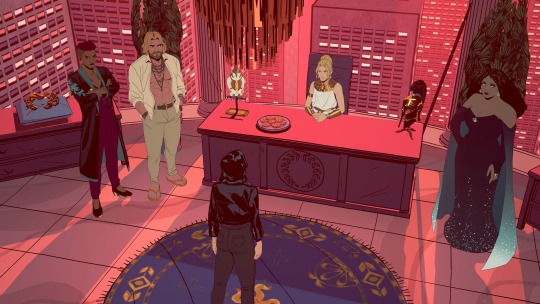
And of course, what’s a musical without its music? The soundtrack of Stray Gods is absolutely incredible, even beyond the incredible amount of work and dedication it took to integrate so many variations of all the songs in the game. Lots of variety with the genre, sometimes even changing in the middle of a song! If I haaad to pick a few favorites, I suppose it’d be The Ritual, Look Into Me, and If Only. I’m a sucker for the emotional songs, but Look Into Me is suuuuuch a banger, it feels so threatening and I LOVE it.

OKAY now I’m gonna gush about my favorite parts of the story and get all spoilery so if you don’t want to be spoiled, DON’T KEEP READING! Go play the game yourself! Iirc it’s on all current platforms. Enjoy :)
So HOLY SHIT APHRODITE’S SONG HIT ME LIKE A BRICK??? I love the moral dilemma her whole cycle of rebirth puts you in, deciding whether to honor her wishes and let her die again or to convince her to find peace in life rather than trying to forget. I tried SO HARD to save her without forcing her and she ended up passing on anyways.
Persephone’s character is also SOOOO well done here, the reinterpretation of her story where she kills Hades is a fantastic direction to take her character. She ended up being my main investigative partner for the game and I did NOT regret it. I almost ended up romancing her, and I definitely will on my next playthrough, but I didn’t this time because of…
Freddie!!! Freddie absolutely rules and is my favorite character in the whole game. Mortal Greek mythology nerd who is super gay and wears a cool hat, how could I NOT love her??? My heart was completely torn to shreds when she died, and even though I knew she had to be able to come back somehow because you could romance her, the fury it raised in me made me blaze through the last four hours of the game and finish it in one sitting XD.
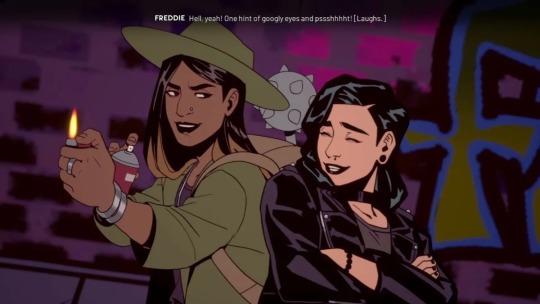
And JEEZ the way they let you bring her back is so well done. It’s not outright good or bad, it’s complex! Freddie and Grace are both traumatized by her death and resurrection, and the fact that you went against Freddie’s wishes and passed the line of Calliope onto her just makes it even more interesting from a storytelling perspective. It’s part of what makes If Only one of my favorite songs in the game. And of course, I’m a sucker for stories of unrequited love like Freddie’s is for Grace and now I’m gonna feel so guilty romancing anyone else 😭. Freddie is so relatable istg.
Anyways uuuuuh that’s all I have to say, maybe I’ll do a full review on my YouTube? Thanks for checking this post out tho! Okay bye :)
12 notes
·
View notes
Note
Ship ranking: Gwen and Morgana!
Squick / Just nope / A trainwreck you can’t look away from / Mehh but they are bloody everywhere / Not interested but no negative feelings / I need to see how I could make it work / BroTP / Cute / I love them / They rented a room in my mind and are here to stay
the only reason this rating isn't higher is because weirdly enough merlin did not change me as a person irreparably. that said, i absolutely adore them, and i love them in so many permutations—canon compliant for the angst? canon divergent for the comfort? modern au just because you can? i love it regardless <3 also your morgwen fics (the touch starvation one and atonement) were so good oh my god.
1 note
·
View note
Note
what's ur ariane/moia galaxy-brained idea?
I'm havin a mimosa excavating archaeology materials this is the perfect time to answer this.
Full disclosure these ideas might need Revisions since it was born a little before the release of archaeology and a good few quests involving moia have come out since then that I havent gotten to so. Y'know.
So basically if you look at both their backstories you can draw parallels and contrasts that work together nicely. Thats the first pillar. Moia found both a mentor and a second father in Zamorak, who supported and taught her where her father Lucien did not.
Ariane found crucial support and encouragement in the wizard Ellaron. Where the rest of her peers rejected her and none of the other senior wizards took her interest in exploring her seer powers seriously, he was her only real support. He encouraged her where others didn't.
Ellaron was a Zamorakian, who was more than happy to use Ariane to destroy the tower at the cost of her own life. Zamorak, on the other hand, values Moia above the rest of his followers (afaik though. might need to brush up.) His most trusted general. When trying to steal the stone of jas, she was the one heading the operation. She was by his side at the battle of lumbridge.
parallels and contrasts. both go well together. More could be drawn to, but I'll stop with this one. Its the most obvious.
The second pillar is more or less the potential in conversation I think they could have, stemming from both ideology but also... Openness. i confess, really reliant on my interpretation of their characters from what we've seen. your mileage may vary, and all that.
Moia, as I recall from the zamorak god book, gives us a strong philosophical idea of what the chaos of zamorak could be. A force of change. hold on this reminds me of a great meme from the official discord I'm going to go nab for ya.
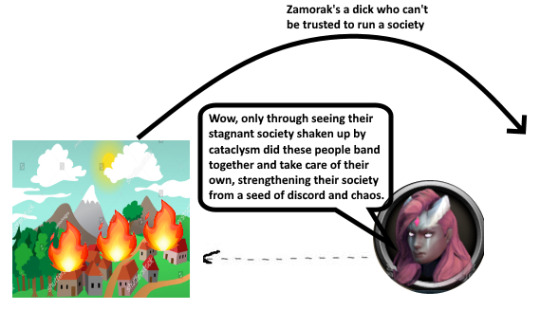
Yeah thats the shit. that'll work for now.
Ideologically Ariane doesn't seem to really behold herself to any one ideology or god. She seems to want whats best for geilinor and its people. She opposes tyranny and cruelty. She also doesn't seem to be all to fond of institutional power. She also doesn't really seem to abide by shunning any kind of knowledge on the grounds of it being forbidden or dangerous. This open mindedness, I feel, could make for really really interesting dialogue with Moia. Actually discussing and dissecting whatever zamorakian ideals moia believes in (and by 'whatever' don't mean to be dismissive. rather i'm referring to how there can be so many different permutations on what being 'zamorakian' means. Appropriate!)
Think the little cutaway conversations between Jessika and Korasi.
Ik when i phrased it as ariane/moia i was evoking shipping but it doesnt need to be romantic. Not at all. I just think, if written well, these two characters could be used to explore many a fun idea!
I did evoke shipping on purpose though! Because lbr, these two could end up end up despising each other just as much as they could get along. I like the idea of there being romantic tension in the mix. The more that could be there better echoes the potential. the chaos. and isnt that what all this is about?
Could say more but I don't wanna. Its been years since i last put these ideas to words and I also want to go do slayer now. hit me up off anon if you'd like to discuss more though!
EDIT: FORGOT TO MENTION i also intentionally wanted to plant the idea of ariane/moia because i think them being involved romantically would be a very entertaining 'its complicated' affair. perhaps even of the toxic yuri variety people seem so fond of. But thats just me.
#runescape#was considering asking you to come off anon but i decided no. no i will say all this publicly#i will say all this tipsy and badly and in general terms. i will plant this seed
1 note
·
View note
Text
More thoughts, after reading a little about Borges and revisiting the intro & ending:
The Greek cast
I'm still probably reading too much into this, but some additional support for Zampanò being aligned with Daedalus comes on page xvi when Johnny lists the objects left in Z's apartment: among them are unused candles (i.e. unmelted wax), and some seashells as well as "the twining metal ridge, looking a little like some tiny spiral staircase, winding down into the bulbless interior of a light socket" which both remind me of the riddle Minos used to locate Daedalus after he escaped the labyrinth (how do you thread a spiral seashell? by tying the string to an ant which crawls through the spiral). I can't make any sense of the "old tube of chapstick with an amber like resin," other than maybe it's some biblical allusion to balm of Gilead or myrrh or something.
However, the main characters also align with other figures in the Icarus story.
Johnny refers to his stories as "inventions" a couple times.
Pelafina, near the end of her life, writes to Johnny about "[her] ascent into [her] new life--drowsy, baked in sun, with you" (p641) and then says Donnie (the pilot) will pick her up soon (p642). And she dies in the sky-blue sheets of the institute. (This seems to make in-text death line up with escape in the myth, while Johnny's ending corresponds to Icarus' death.)
If Johnny is the Minotaur rather than Icarus, Zampanó could then be Minos, who was also responsible for constructing the labyrinth. And according to Thucydides, Minos was the first man in history known "to have built a navy". Interesting!
And there are many other characters from Greek myth that have ties to the story:
Apollo, god of the sun and many other things relevant to HoL, who also has a role in the Icarus story (Daedalus builds a temple to Apollo after his son's death)
The Cumaean Sibyl, mentioned on p642 and likely alluded to in multiple places (also, according to Wikipedia: "In an invention of Virgil (Aeneid VI), Daedalus flies to Cumae and founds his temple there, rather than in Sicily.")
The 9 muses, which may map to Johnny's lovers (the number 9 also shows up a lot in general)
Thamyris, whose name appears encoded on p77 and p387 (the latter called out on p514)
Poseidon, who is associated with water (duh) and Pisces, and in myth provides the bull and the curse that lead to the Minotaur's birth
Hyacinth, namesake of the purple flower
Zephyrus, god of the west wind, and Boreas, god of the north wind (cardinal directions come up quite a bit, and the cover prominently features an unlabeled compass rose)
(The last three points I mainly include because they have direct ties to the others in myth; their HoL presence is weaker.) It could be fun to try to trace out all the potential connections and parallels between these characters and those in HoL. You might even include the storytellers, like Virgil.
Borges
In addition to the tiger poem from my first post, the rest of Borges' writing is extremely relevant to HoL.
The House of Asterion (I'm going to spoil it in this sentence, watch out! Final warning!!) tells the story of the Minotaur from the creature's perspective, though it obscures that fact until the last line. It also puts the number of youth sacrifices, which often varies between tellings, at 9.
The Library of Babel describes an infinite library stocked with books that contain every possible permutation of letters, so that every story and idea must be contained somewhere within the library by pure chance.
The Garden of Forking Paths describes a book that includes a chapter about every possible outcome of each event in the story, introducing the idea of branching futures.
Pierre Menard, Author of the Quixote is a fictional review of an (also fictional) academic work by the character Pierre Menard, who wishes to understand and reconstruct the story of Don Quixote at a deeper level than mere translation. He does this by immersing himself in the original author's history and context until he can independently recreate the whole story word-for-word. The "reviewer" than asserts that this identical recreation is necessarily richer than the original, because it was created more recently and thus can be interpreted as alluding to historical events that occurred after the original was written. (Directly referenced in footnote 49 on p42.)
The Writing of the God is about an imprisoned priest who looks for the titular divine message in the patterns of a jaguar's fur. In the end, he has a vision of a wheel made of both water and fire simultaneously, which allows him to understand the writing in the fur. However, upon understanding the writing, he no longer has use for it, because it has given him a broader perspective of the universe that makes him forget or not care about his individual self. This is one way to interpret Johnny's ending, and helps reconcile the themes of blue and red in HoL, as explained in the next section (Purple).
All five stories are included in the collection Labyrinths.
Purple
I already noted some of the associations for blue (see "House" in first post), and I guess those also relate to birth and creation. In the text, fictional commentators compare the House to motherhood (the darkness of the womb) as well as "narcissism's paternal darkness" (p357-358).
(There's probably something here also in Johnny's many sexual escapades. He sows his wild oats without the aim of conceiving; he spews long and rambling footnotes without much thought or purpose. There's also the "P spot" mention in his encounter with Tatiana (p109), which is an interesting term to use considering that his mother signs her letters "P.")
So the purple overlap of blue (creation, birth, potential) and red (death, loss, absence) could be either a negation (birth undone by death) or an eternal cycle (death "undone" by birth, ad infinitum), depending on how you look at it. In this view, it makes sense that purple is Pelafina's color, considering that she both birthed and attempted to kill Johnny; and more figuratively, she likely gave him both his creative spirit as well as his tendency to madness and self-destruction.
The idea of cycles may be connected to the symbol O (which is missing from Pelafina's final sign-off on p642, missing twice in the code on p64-67, and present in the Yggdrasil poem on p709). It's typically also connected to the Ouroboros, though I think that's only referenced obliquely in the text, if at all. Looking back at some of the cycles depicted in HoL (see "House" in first post, last paragraph), as well as the idea of looping around a maze to return to the same point (p114, footnote 136, for example), we could probably conclude something trite like "re-treading the same ground can still be progress if it changes you". A man cannot step in the same river twice.
(In Johnny's nightmare on p403, the frat boy Theseus also wears purple, and he butchers Minotaur!Johnny, then vomits--an ugly sort of destruction and creation. I'm interpreting this as a jab at sophomoric "analysis" of a text; a "hack job," if you will. Dismantling without regard for the connections between elements, and projecting your own ideas that have no connection to the material. Maybe Johnny and/or MZD's most pessimistic vision of how HoL could be received. But I'm sure it's other things, too.)
Lastly, I've seen others mention that the blue of house is similar to a hyperlink in basic HTML, but I didn't connect it to my own color interpretation, so I'll do that now:
blue is the color of an unvisited link, which matches the association with potential and creation/birth
red is a link to a missing page, matching the association with absence; you could also call this a "dead" link
purple is a link that you have visited before; it no longer has the unexplored potential of a blue link, but the page still may have changed since the last time you visited it, in which case the old page that you knew is gone. I think this aligns well with the concept of cyclical rebirth.
Ecce Puer
In the story of the cyanotic child, the mother says something which phonetically matches up with Ecce Puer ("Behold the boy"), a James Joyce poem about his grandson being born shortly after his father's death. This ties into the theme of cycles of death and rebirth.
The last line Johnny writes, on p521, is "The child is gone."
Who or what is born from this? And who or what do they succeed?
Death of the Author
My copy of HoL happens to be signed. MZD wrote a short message in blue ink, and then signed with a large Z in green marker. The Z has a line through the center, which can be a stylization, but is more likely a crossing-out, as Derrida apparently liked to do with his signatures.
(I'm curious if there are any consistent associations with green in the text. There's Karen Green, obviously, and the Minotaur in Chiclitz's play is called Mint. In pigments, green is the combination of blue and yellow, and the complement of red. Generally, it would be associated with plants, and especially new/fresh leaves.)
MZD seems to play the role of Zampanò to the reader's Johnny. In a sense, the death of the author is the birth of the reader; the author's work is complete when the book is published, at which point readers can begin to form their own interpretations. As Johnny writes on p327:
There's only one choice now: finish what Zampanò himself failed to finish. Re-inter this thing in a binding tomb. Make it only a book, and if that doesn't help . . .
Johnny isn't a dead author to us, though. He speaks directly to the reader throughout his notes. For instance, on page xvii, describing the manuscript:
I know a moment came when I felt certain its resolute blackness was capable of anything, maybe even of slashing out, tearing up the floor, murdering Zampanò, murdering us, maybe even murdering you.
Of course, if Johnny is only a character in his own book--ink on a page--then the end of the book is also his end, and the destruction of the book (the scattering of leaves to the wind) would be his destruction. Again on p327:
That long anticipated disintegration, when the darkest angel of all, the horror beyond all horrors, sits at last upon my chest, permanently enfolding me in its great covering wings, black as ink, veined in Bees' purple. A creature without a voice. A voice without a name. As immortal as my life. Come here at long last to summon the wind.
There are some hints here--the inky creature as both the manuscript and death, the uses of voice which I think elsewhere is associated with authorship and godhood--but I can't quite tie it all together.
Derrida's Différance
On p515, Johnny writes, "What's the difference, especially in differance, what's read what's left in what's left out what's invented what's remembered what's forgotten what's written what's found what's lost what's done?"
I'm just going to quote this whole section from the Wikipedia page on Différance:
Différance is a French term coined by Jacques Derrida. It is central to Derrida's concept of deconstruction, a critical outlook concerned with the relationship between text and meaning. The term différance means both "difference of meaning" (différance) and "deferral of meaning" (différance), and is made of combining the two French words. Roughly speaking, the method of différance is a way to analyze how signs (words, symbols, metaphors, etc) come to have meanings. It suggests that meaning is not inherent in a sign but arises from its relationships with other signs, a continual process of contrasting with what comes before and later. That is, a sign acquires meaning by being different from other signs. The meaning of a sign changes over time, as new signs keep appearing and old signs keep disappearing. However, the meaning of a sign is not just determined by the system of signs present currently. Past meanings leave "traces", and possible future meanings "haunt". The meaning of a sign is determined by the interaction between past traces, future haunts, and the system of signs present right now.
Twin cargoes
As noted in my first post, twins or pairs of siblings are a recurring element in HoL. (p248: "[Zampanò] suddenly claimed [the comparison of Tom and Navy to Esau and Jacob] was justifiable only if you could compare any pair of siblings to Israel and his brother.") Karen has one sister; the Navidsons have two children; MZD has one sister; Apollo and Artemis (associated with the sun and the moon, respectively) are twins.
This probably echoes a more general theme of duality, pairs, and inverses throughout the book. It also suggests that Johnny could have had a twin or sibling, either literally or figuratively.
Near the end of the story of the Atrocity, which carried "two cargoes within its holds, one secret, the other extremely flammable" (p298), Johnny writes of the last trapped survivor (p300):
I'm losing any sense of who he was, no name, no history, only the awful panic he felt, universal to us all, as he sunk inside that thing, down into the unyielding waters, until peace finally did follow panic, a sad and mournful peace but somewhat pleasant after all, even though he lay there alone, chest heaving, yes, understanding home, understanding hope, and losing all of it, all long long gone a long long time ago . . . shhhhhhhhhhhhh . . . when next to him, not a foot away, lay Something he never saw, no one saw, for he had come upon the secret when he escaped into this cargo hold but never knew it, though it might have saved him, saved us all for that matter, but it's gone, letters of salt read by the sea . . . and I too have lost The Atrocity . . . and the sun pours in on me, surfaces once transparent now reflect, like a sea of a different sort, and I forget my ship, or I lose sight of it, or is that the same thing? to a time long before I saw in my own holds two cargoes, one a secret, the other extremely flammable, the flammable put there by invisible hands for invisible reasons . . .
The "sea of a different sort", which reflects the sun, sounds to me like the "seas" of the moon (e.g. the Sea of Tranquility). I have no good guesses for what the secret cargo is, though--either in the ship or in Johnny. But it definitely seems to parallel the twins in the womb from p249. Unfortunately, The Atrocity is the most interesting part of the book that I have no real theories for.
Cats
On page xviii, Johnny references the saying "curiosity killed the cat, but satisfaction brought it back," before quoting lyrics from "(I Can't Get No) Satisfaction" by the Rolling Stones. There are a lot of dead cats in House of Leaves, and we don't see any of them come back.
This is a VERY long text post.
thanks @squareallworthy for giving me the excuse to make a House of Leaves post!! I'm going to try to make this accessible to everyone, so:
If you haven't read HoL, feel free to bail if this goes too deep or stops making sense. Personally, I don't think you need to worry about spoilers because it's not that kind of book (it usually spoils itself anyway), but if you'd rather go in knowing nothing, slam that J key now.
If you have read HoL, feel free to skip ahead to the theories. You're presumably good at tuning out extraneous information by now. :)
What is House of Leaves?
House of Leaves is a novel by Mark Z. Danielewski (MZD), published in 2000. It's an example of postmodern literature, which according to Wikipedia is:
a form of literature that is characterized by the use of metafiction, unreliable narration, self-reflexivity, intertextuality, and which often thematizes both historical and political issues.
...all of which is House of Leaves to a T. Rather than capturing a single narrative, the book's text layers multiple stories, which refer to both each other and to external (e.g. mythical) stories, and which often reference the fact that they are stories in a book.
You can find it archived here, though unfortunately that scan/OCR seems to mangle the text in ways that will be hard to distinguish from everything else it's got going on.
Overall, I think the book is really cool and interesting, but maybe not worth sinking a ton of time and effort into. It's not a fun or easy read. Definitely worth checking out, but don't be afraid to skim or abandon it if it's not your thing.
The layers of HoL
The innermost layer is The Navidson Record (TNR), which is ostensibly a documentary but effectively a found-footage horror film. It's a series of films about the Navidson family--an unmarried couple with two young children--moving into a house in Virginia, and discovering that something is very strange about it. First subtly and then dramatically, the interior of the house grows and changes, in defiance of physical laws. One closet in particular becomes an eerie and seemingly infinite labyrinth, which they explore at their peril. (Don't worry--the overall novel is creepy and sometimes upsetting, but not outright scary. I'm a weenie about horror and had no trouble.)
The next layer is a pseudo-academic text about TNR by a blind man named Zampanò. He recounts the events of TNR, but also meanders on long tangents about other stories or academic works.
The third layer is the primary one we experience as the book House of Leaves. A character calling himself Johnny Truant discovered the disorganized and incomplete manuscript in Zampanò's apartment after that man's death, and he has assembled and edited it into this book, as well as added an introduction and lengthy footnotes relating stories from his own life. Johnny often contradicts himself, freely admits to making things up or changing the previous layers to suit his whims, and appears to mentally deteriorate over the course of the novel. He also says he can't find any evidence that TNR actually exists.
There's a thin layer added by "the Editors," who supposedly received the text from Johnny, and published it while in contact with him. They add some appendices and minor notes throughout, mainly to provide English translations for certain excerpts or to state that something the text refers to is missing. They include a purported still frame from TNR in the appendices, with no comment from Johnny.
All of the above, of course, was actually written by MZD, the real-life author of HoL. He self-published the earliest version of HoL to the internet, before publishing the full version as a physical book. He also produced some teleplays related to the work, and a collection of letters from Johnny's mother. The letters were originally published separately, but now most of them are included as an appendix to HoL. MZD's sister, the singer-songwriter Poe, also released the album Haunted around the same time as HoL, and it serves as a companion or counterpart to the novel.
The final layer is us, the readers. We interact with the text and also with each other, like I'm doing with this post. MZD's website still hosts forum threads from the time the book came out, where readers deciphered and theorized about it together. This is an important and intentional aspect of the work, as I'll explain in more detail later (see "The Meta").
Sub-stories
There are a few smaller anecdotes within the text which almost serve as their own layers, but don't fit neatly into the hierarchy above:
The Chiclitz play The Minotaur, on p110-111
The story of The Atrocity, on p297-300
The story of the changeling/cyanotic child, on p518-521 and referenced obliquely on p48-49
Themes and motifs
A non-exhaustive and highly subjective list, ordered very roughly from the most to least prominent:
The Greek myth of the Minotaur and the labyrinth
House
Madness, memory, and meaning
The sea and the sky
Darkness, absence, emptiness
Yggdrasil, the world tree; trees, leaves, and paper; the Cumaean Sibyl
Fidelity (in multiple senses of the word)
Colors, especially red/blue or red/blue/green/yellow
Death and rebirth, procreation, the womb
The biblical myth of Abraham and his sons
The biblical myth of Jonah and the Whale
The eye, cameras
Head injuries, holes in the head
Families, especially parents and twins/pairs of siblings
Note that there are connections and overlap between these themes. I'm going to argue that the first few in particular are strongly intertwined.
The Meta
Most of the fan theories I've seen are focused on the usual concerns: "what do you think really happened in the story? what does this mean for the characters?" That's reasonable, but since HoL is extremely aware of itself and its readers, I think it's also worth asking what the text expects from us or what it's trying to communicate directly, if anything. IMO those questions are easier to answer than nailing down the events of the story, and that's on purpose.
While rightfully regarded as a challenging and puzzling book, HoL actually is pretty blatant about helping us "solve" most of it. Heck, it color-codes its major motifs. There were many instances where I was like "oh, this reminds me of that other part from a ways back" and then the footnote would tell me to refer back to that part I was remembering. When there's an encoded message, like the Morse code or first-letter sections, Johnny typically makes a comment providing the key to decoding it--and in some cases also tells us the "hidden message," like in his conversation with the band near the end of the book.
The book straight-up tells you how to read it. On p115, just before it starts getting really wild with the typesetting in a section structured like a maze, Zampanò's text gives this advice for navigating mazes:
In order to escape then, we have to remember we cannot ponder all paths but must decode only those necessary to get out. We must be quick and anything but exhaustive.
The next footnote (139) also warns: "[in a maze,] the faster you go, the worse you are entangled" and "If one reads too quickly or too slowly, one understands nothing."
And of course, the book provides an extensive (albeit somewhat playful) index, so that if you have a theory about a certain word or concept, you can easily go back and look up examples. I believe the page numbers also match up across editions, so that different readers can more easily confer with one another.
All of this strongly suggests that MZD very much wants us to view the text as a puzzle to decode with other readers. He makes sure we know there are patterns and hidden messages to be found.
The madness of analysis
Like I mentioned above, Johnny's mental state deteriorates over the course of the book. A lot of his story also has to do with his late mother, who was committed to a psychiatric institution when he was young, and who shows similar quirks and inconsistencies in her letters to Johnny. The reader is quickly clued in that Johnny is an unreliable narrator, and by the end of the book it's nearly impossible to untangle what "really happened" in Johnny's narrative because there are so many revisions and contradictions.
Zampanò's writing may seem like a sharp contrast to Johnny's, since it is stuffy and academic rather than casual and coarse. But the two strongly parallel each other, as do the two characters. They both ramble and are prone to lengthy tangents based on tenuous connections; Zampanò seems to make things up and messily add and redact just as Johnny does with his stories. Both seem haunted by and obsessed with the manuscript in similar ways.
Other HoL readers have called it a satire of academic texts, but I'd go a step farther and say it's drawing a parallel between (perhaps overzealous) academic analysis and psychosis: seeing patterns or connections where there are none, jumping to wildly different and sometimes bizarre conclusions from the same experience, getting lost in theories with little connection to reality, communicating in ways that are hard for others to understand.
It even encourages its readers to engage in the same behavior, by hinting at many different patterns and connections yet making them inconsistent, uncertain, and contradictory. It goads you into trying to analyze it, but you'll just end up like Charlie in the Pepe Silvia meme:
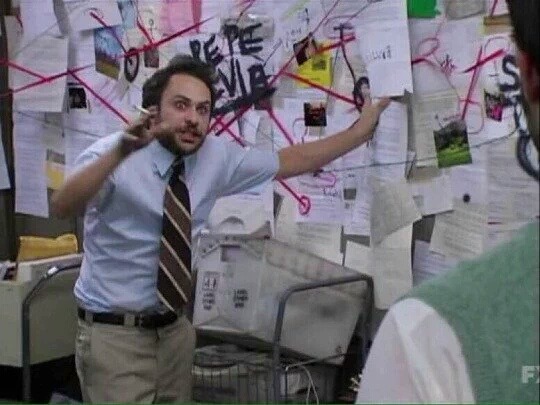
Derrida's Deconstruction
Wait, so does that mean it's futile to try to analyze House of Leaves? Well, sort of, and the book tells us this! Remember that part (see "The Meta") that was giving us advice on how to navigate a maze, i.e. the book? On that same page, p115, it also says:
Unfortunately, the anfractuosity of some labyrinths may actually prohibit a permanent solution. More confounding still, its complexity may exceed the imagination of even the designer. Therefore anyone lost within must recognize that no one, not even a god or an Other, comprehends the entire maze and so therefore can never offer a definitive answer. [In the Navidson house,] any way out remains singular and applicable only to those on that path at that particular time. All solutions then are necessarily personal.
This sounds a lot like Deconstruction and Post-Structuralism, which isn't a coincidence given that Derrida was just quoted on p112. From the Wikipedia page on Deconstruction:
Derrida's deconstruction strategy is also used by postmodernists to locate meaning in a text rather than discover meaning due to the position that it has multiple readings.
It's probably also relevant that most of the book is about Johnny interpreting a text after the literal death of the author.
Footnote 140, which comes after "even the designer" in the above excerpt, includes this, in red and crossed out:
Or in other words: shy from the sky. No answer lies there. It cannot care, especially for what it no longer knows. Treat that place as a thing unto itself, independent of all else, and confront it on those terms. You alone must find the way. No one else can help you. Every way is different. And if you do lose yourself at least take solace in the absolute certainty that you will perish.
This ties the more general advice on interpreting texts back to the specific narratives in HoL. Before we dig into that more in the next section, note that Derrida was also a fan of putting things "under erasure" by crossing them out. Hmm...
Madness and the Minotaur
In multiple ways, the Minotaur is associated with absence. Most obviously, text mentioning it by name usually only appears in red and crossed out--Johnny says these are sections he recovered after Zampanò tried to erase them. The Minotaur also seems to be absent within TNR; the labyrinth of the House suggests its presence through growls and slash marks, but a beast never actually appears, and instead, things within the labyrinth seem to gradually fade out of existence. In myth, of course, the Minotaur was removed from society by hiding it in the labyrinth, and was eventually slain by Theseus, obliterating it forever.
On p335 we get footnote 295, again in red and crossed out:
At the heart of the labyrinth waits the Mi[ ]taur and like the Minotaur of myth its name is [ ] Chiclitz treated the maze as trope for psychic concealment, its excavation resulting in (tragic[ ] reconciliation. But if in Chiclitz's eye the Minotaur was a son imprisoned by a father's shame, is there then to Navidson's eye an equivalent misprision of the [ ] in the depths of that place? And for that matter does there exist a chance to reconcile the not known with the desire for its antithesis?
(The footnote continues, making the shape of a sword with large gaps in the blade.) Empty brackets in this section supposedly denote burnt holes in the manuscript, but since they are consistently used to make puns, it's clear that at least one of the authors is being intentional. We could read the gaps here as literal: the name of the Minotaur is [nothing], the labyrinth conceals the treacherous [nothing] in its depths.
The chapter that footnote appears in (Chapter 13), which is titled The Minotaur, begins with a quote that is translated as so (p313):
a slow shadow spreads across the prairie, but still, the act of naming it, of guessing what is its nature and its circumstances creates a fiction, not a living creature, not one of those who wander on the earth.
In this poem, El otro tigre, Borges compares a tiger in a poem, made of words and symbols, to "the other tiger" of flesh and blood, out in the wild. No matter how he tries to capture it with writing, the real tiger will always elude him.
So the Minotaur is connected to absence, nothingness, emptiness, and so on. This chapter draws additional associations with death and madness, which of course are also forms of loss or absence--both of self, and of meaning.
Is Johnny the Minotaur?
Johnny is strongly associated with the Minotaur, but his exact relationship with it is more complex than simply "Johnny is the Minotaur" or "the Minotaur represents Johnny". He is stalked by the creature in various forms, and he has nightmares or delusions in which he is the Minotaur. Raymond, the abusive foster dad, calls Johnny "beast". I think it's most accurate to say he is scared of the Minotaur and scared of being or becoming it, especially if we're interpreting it as nothingness or madness. And we know how his story ends.
There's another association I make with Johnny which isn't as explicit and doesn't seem to have been discussed as much, and that is to Icarus. There are hints of this early on--his father is a pilot, he's strongly associated with the sea and drowning, his fantasy when he meets Thumper sounds like flying--but it's brought home in the story about getting the scars on his arms, on page 505, and all the allusions and imagery. He burns and then drowns.
Zampanò, likewise, is like Daedalus. He built the labyrinth that is the manuscript, and which traps both Johnny and himself. There are some suggestions in the text that he and Johnny are like figurative (or in some theories, literal) father and son. But Daedalus, unlike Perilaus, was able to free himself from his own invention, and it seems like this wasn't true for Zampanò.
(This may be too much of a pet theory; I'm not sure it's as well-supported as the other parts of this post. But there's something there, I'm pretty sure.)
House
A house is a structure that defines empty space and imbues it with meaning by separating it from the greater nothingness. The novel is likewise a structure that gives form to a particular nothingness (fiction) by defining it and separating it from the greater nothingness (everything else that has not happened).
As readers, we follow a narrative "thread" through the text, but encounter only the Minotaur (nothingness) within. Just as the Minotaur in Chiclitz's play was portrayed sympathetically, the absence does not need to be bad or monstrous--it's just nothing. As we see in the key shape of footnote 123 (p110-111), the Minotaur is the key, but there is no Minotaur. There is no key. The key is crossed out (both the text comprising it, and the key itself, by being split across two pages). Perhaps we "slay" this Minotaur by imposing our own meaning? Would that be noble or tragic?
The house itself is what matters, but the house is blue, and blue means open to interpretation--what a blue screen meant in the 90s, before digital film became the norm. Everyone projects their own thoughts and fears onto the house, and it reflects those back at them. It's meaning and memory; you get out of it exactly what you bring. Blue is shifting and unfathomable like the sea. You could lose yourself in its depths.
Though "out of the blue" specifically seems more like a deus ex machina, because I'm pretty sure the blue of the sky is associated with God, eyes/cameras/observers, and us (MZD and the readers), though I don't have examples prepared to back that up. "Shy from the sky" (see "Derrida's Deconstruction") could then be taken as "don't look to the author for answers".
But if there is any meaning to be found, it also can't be found looking only within the text and the world it defines, without considering those final layers. The stories all intertwine and even loop back on themselves, as when Navidson and Johnny both encounter their own book. Using the HoL to light your way through HoL will lead nowhere. You'll need help from the outside.
So?
Okay, okay, okay. So what?
"SO?" asks the text (p103), and maybe you do, too. Sew buttons, says the Morse code of footnote 119 on the same page. Dismissing the question? Or suggesting you work hard to secure your buttons with a whole spool of thread, as Johnny does near the end (p514) to avoid losing them to the labyrinth?
Shortly after, on p516, Johnny writes this:
Wasn’t darkness nothingness? Wasn’t that Navidson's discovery? Wasn’t it Zampanò's? Or have I misconstrued it all? Missed the obvious, something still undiscovered waiting there deep within me, outside of me, powerful and extremely patient, unafraid to remain, even though it is and always has been free.
This (and some of his other writing late in the story) reads to me like possibly an acknowledgement or dim awareness of reality outside the book, but I'm not sure. I'm just going to point to it, and also the part a little further down the page, where he describes a sunset as "Reds finally marrying blues."
How do we reconcile red and blue? Is it about reconciling ourselves to the lack of true meaning, as in Nihilism? Or choosing to focus only on the "real", refusing to lose ourselves in the endless cycle of interpretation?
I don't know. There's probably more that can be built on this foundation, but this is as far as I've gotten. If you actually got through all that, wow, thanks for reading, and by all means let me know your own thoughts.
#hol#house of leaves#theorycrafting#literary analysis#my hol interest fell off before finishing this post so I won't be posting more on this#except possibly to reply to people
34 notes
·
View notes
Note
Alpha is very Burnt Out Church. Like... Constantly burnt out. Its been pointed out by the others, under plenty circumstances, that Epsilon does not act like Church / Alpha did. He was either more whipped, or he blew up more spectacularly. Alpha is more Objective, Epsilon is more Personal. Alpha took things, no matter how ridiculous, at face value. While Epsilon is more prone to reason his way out. Alpha was more willing to let Tex do her own thing... Epsilon was not.


you have the incredible power to say exactly what ive been thinking about for days. here’s my fix
warning: im about to speak with authority even though i function by throwing spaghetti at the wall. if anything about this is wrong or egregiously off please tell me so i can eat the proper crow
epsilon had to have sacrificed himself for tex so she could escape the memory unit, and have the chance to become her own person completely outside of church in order to complete his predetermined arc.
(i love epsilon, love him and carolina, and in an rvb rewrite i would not be able to bring myself to do this and i come up with an alternate ending- this is just in the terms of, what the director laid out as his character arc, and how rvb TRIED to do progressive iterations of the director’s story, and then massively dropped the ball with the ending)
You see, I never had the chance to serve in battle, nor did fate provide me the opportunity to sacrifice myself for humanity as it did for so many others in the Great War. Someone extremely dear to me was lost very early in my life. My mind has always plagued me with the question, if the choice had been placed in my hands, could I have saved her? The memory of her has haunted me my entire life, and moreso in these last few years than I could ever have imagined. But given the events of these past few weeks, I feel confident that had I been given the chance, I would have made those sacrifices myself. Had I only the chance.
and no version of himself ever did make the sacrifice to save her. the director doesn’t really deserve the term sacrifice applied to him, but he did sacrifice everyone around him. he sacrificed his daughter, his military organization, countless lives, literally everything, in order to chase after allison. this is obviously the darkest, worst version.
alpha did sacrifice himself for tex- it’s more explicit in the deleted scene where wash convinces him to go by bringing up tex specifically and finding out about her, *which i can’t find a link to but if anyone has it please send it to me.) but he didn’t save her. they died together, which is tragic and as you said, they never figured out the truth. but in a way, they didn’t need to. alphabeta is a much stronger relationship than epsichex because they like, know each other as their own people and church doesn’t know who allison was. it is tragic they neveer learned who they were, but it makes sense for the second iteration.
and then epsilon.... regresses. he sacrifices HER. yes it is him giving up on chasing the memory like the director did, but the director’s biggest crime isn’t just refusing to give up on a memory, it’s what it did to tex. how it stripped her of all agency and made her fucking miserable. this is so explicit in epsitex’s actions. she resents being made, but if she’s gonna exist, she’s going to do it on her own terms. beta came along for the ride, she made herself. epsitex didn’t.
and then epsilon makes her last words to him “i love you” and kills her.
(also... epsitex is made from epsilon’s memories of tex. the fact that epsitex always fails is just as much his fault for not seeing her as anything else as it is the director’s.)
there are only two ways to complete epsilon’s character arc well, because no matter what he needs to let tex LEAVE. not die, just exist as a person outside of him. you can interpret i forget you as that, but it isn’t her fucking choice to stop existing. just because she didnt ask to be made doesn’t mean he should have the power to execute her. she needs to be allowed to exist without him, figure out who she is. and, if you wanted to wrap up the narrative of church becoming a better person through iterations, him actually finally making the sacrifice and SAVING tex would be the final permutation.
i used to think this was the best option but through writing this post, i think epsilon saying fuck you to the director spiritually by refusing to give him the heroic sacrifice he always wanted is the best, most satisfying option. and them being strong enough to leave the memory unit together (which would have to be established as impossible) would be a nice parallel with beta being strong enough to make her own person. and it would make the end of s10 hit so much harder, because epsilon didn’t just do better than him, but completely subverted what the director wanted for him.
outside of killing tex, i think epsilon is a super good character and exploring his relationship differences with the bgc vs alpha is something i’m super interested in (and something that @leonardalphachurch has done great meta on). not to mention, single mindedly focusing on tex instead of everyone else is another one of the director’s flaws that epsilon can overcome! he needed to put some serious work into his friendships that we never got from s12 or 13, sadly. and him self isolating with carolina can be an accidental repeat of the singlemindednesss cycle because he wasn’t focused on tex, and him realizing he cares about tucker and caboose and needs to show it better and stop pretending that him not showing emotional vulnerability makes him more like alpha and could be like a character moment or something.
and then tex can go explore the universe off screen for 3 seasons before coming back to chorus in s13 on her own to kick some ass. also the flashback montage episode of her hijinks and exploits that we missed like s15e6, please god give it to me.
#rvb#journal entry#files#oh my god don't look at my original takes im so much better at regurgitating other people's#this is so scary#along with rose's takes i also used epsilontuckers to cobble this together#iim not smart#DOING META MAKES ME SO PRETENTIOUS IIM SORRY#the-mercurial-star-o-vesper#long post#asks#ALSO ALL THE CHURCHES SHOULD HAVE BEEN WOMEN AND CHEX SHOULD HAVE BEEN LESBIANS.
107 notes
·
View notes
Text
This is a great article about how The Card Counter managed to finish principal photography after getting shut down mid-March due to COVID-19.
Also, it includes this interesting description from Paul Schrader about Oscar Isaac’s character, William Tell -- “So now I have a character and he’s in his room, he’s alone. And he has a mask on. And the mask he wears is a professional poker player. And the problem that runs alongside him is that he is a former torturer for the U.S. government. So it’s a mix of the World Series of Poker and Abu Ghraib.”
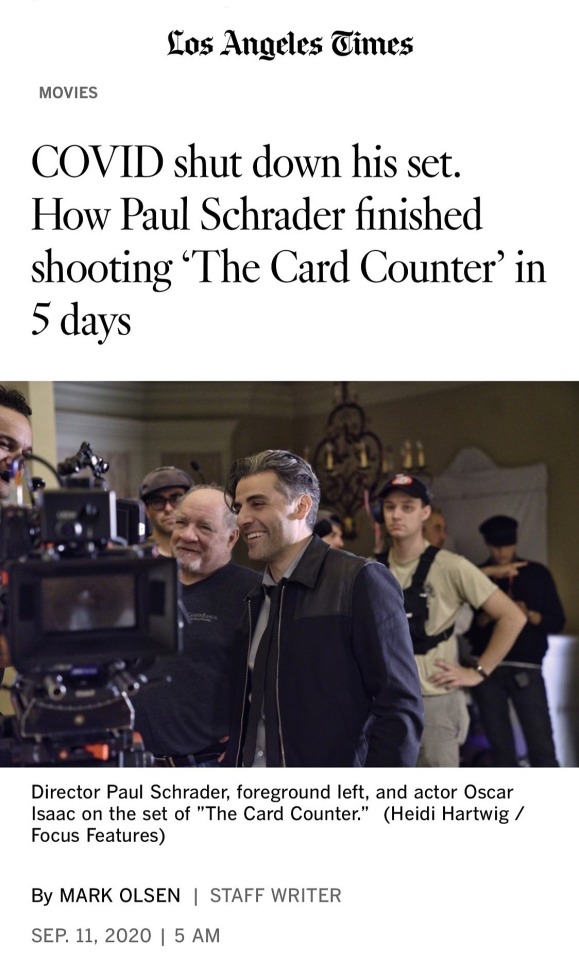
Having somehow weathered his way from enfant terrible to wizened survivor, Paul Schrader is a filmmaker who is simply not finished yet. Every time it might seem his career is on the wane, he resets, revitalizes and comes back again.
Just a few years after his 2014 film “Dying of the Light” starring Nicolas Cage was taken away from him by financiers — leading Schrader to disavow the movie — he received his first Oscar nomination (for original screenplay) after directing “First Reformed,” which was released in 2018 and starred Ethan Hawke as a troubled small-town minister.
Schrader’s work is marked by emotional intensity, intellectual vitality and an aesthete’s appreciation of style. His filmography is full of unusual corners that are still being discovered. The 1979 film “Old Boyfriends,” directed by Joan Tewkesbury with a screenplay by Schrader and his brother Leonard, was recently rereleased on home video. As was the 1990 film “The Comfort of Strangers,” directed by Schrader from a screenplay by Harold Pinter.
He’s been directing films from his own scripts since 1978’s “Blue Collar” starring Richard Pryor, Harvey Keitel and Yaphet Kotto. He went on to write and direct such films as “Hardcore,” “American Gigolo,” “Mishima: A Life in Four Chapters,” “Light Sleeper” and “Affliction.” His celebrated work as a screenwriter for director Martin Scorsese includes “Taxi Driver,” “Raging Bull,” “The Last Temptation of Christ” and “Bringing Out the Dead.”
Never one to shy from controversy onscreen or off, he directed Lindsay Lohan in the 2013 Hollywood-set thriller “The Canyons,” written by Bret Easton Ellis.
In March, Schrader was about three-quarters through the shoot for his next film, “The Card Counter,” in Mississippi — with a cast that includes Oscar Isaac, Tiffany Haddish, Tye Sheridan and Willem Dafoe — when the production was shut down due to the growing pandemic. In July, Schrader was able to shoot for an additional five days to complete production.
During the break in shooting, “The Card Counter” was picked up for distribution by Focus Features.
Schrader recently got on the phone to talk about the unusual circumstances of the film’s production and completion. A film critic before he became a filmmaker, Schrader not only had startling insights into his work, but also thoughts about what filmmaking and exhibition might be like in a post-COVID world.
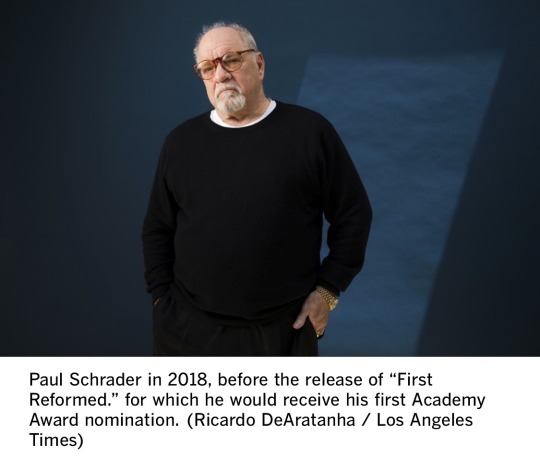
Before we start talking about the production on the movie, could you just describe the story? What is “The Card Counter” about?
Well, I don’t want to get too deeply involved in the plot, but what I will say is over the years I’ve kind of developed my own little genre of films. And they usually involve a man alone in a room, wearing a mask, and the mask is his occupation. So it could be a taxi driver, a drug dealer, a gigolo, a reverend, whatever. And I take that character and run it alongside a larger problem, personal or social. It could be debilitating loneliness like in “Taxi Driver.” It could be a midlife crisis like in “Light Sleeper.” It could be an environmental crisis like in “First Reformed.”
So now I have a character and he’s in his room, he’s alone. And he has a mask on. And the mask he wears is a professional poker player. And the problem that runs alongside him is that he is a former torturer for the U.S. government. So it’s a mix of the World Series of Poker and Abu Ghraib.

How did you come to put those two things together?
I’m always looking for that. I’m looking for deep-seated problems, either personal or societal, and some kind of oddball metaphor. The more you get closer, you run these two wires next to each other, the more sparks you see flying across. And it’s in the sparks that the viewer comes alive. If the wires ever touch, there’s nothing left for the viewer to do. But if you keep these two wires really close to each other, the viewer will start to spark from one wire to the other. And that’s the greatest thing you can give a viewer or a reader, an opportunity to be part of the creation.
Let’s talk about the production and everything you’ve been through. Take me back to March. What was it like for you when the production had to shut down?
I have learned in my dotage how to make a quality film on a low budget. So the film I used to make in 40 days I now make in 20. And so “First Reformed” was 20. I had shot in Biloxi 15 days. Now I knew coronavirus was going to be rising, because when I heard that Macau shut down, I said, you know, it’s just a matter of time. Macau is the wealthiest gambling center in the world and I’m here in the gambling center of the Gulf. If Macau shuts down, it’ll reach Vegas, it’ll reach here. And we were doing a scene, a poker tournament with 500 extras. And I remember I said to the A.D., “We can’t put 500 people in a room without one of them being positive.” And sure enough, one of them was. Two days later, we not only closed down, all of the Gulf was closed down.
Fortunately, when I went back, I had shot my big crowd scenes. And also I had shot my sex scenes, which I would have hated to try to do under these restrictions. So all I had left when I went back was a number of scenes in the prisons, and four more scenes in the casinos, some driving scenes. So I was in pretty good shape. But I really wanted to finish the film.
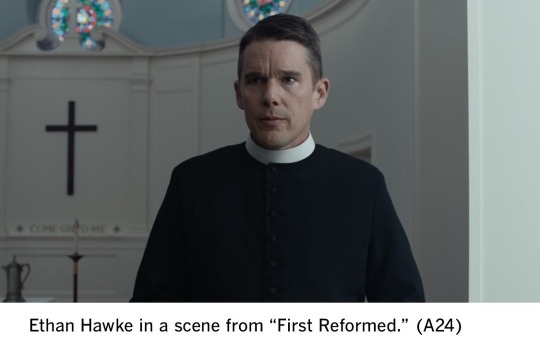
And Oscar Isaac, he was on his way to Hungary to do reshoots for “Dune.” And he wanted to put off this reshoot till after “Dune” — to do it in September because he has a big beard and he didn’t want to shave off his beard. I said to him, “Oscar, there’s a window open right now in Mississippi.” I said, “If we don’t jump into this window while it’s open, this will become one of those famous films that never got finished, and we’ve got to exploit this moment.”
So I talked him off the ledge and he agreed to do it. And we were able to put everybody back together and do our week of prep and five days of shooting. It was very strange, and in a way it was kind of fun, in a summer camp sort of way. But I would hate, hate to make a whole film this way. It was an adventure for five days, it’s a nightmare for five weeks.

In the break from March to July, were you on high alert that you could come back at any moment? Were you editing the footage you already had?
Here’s what happened. I was editing. My editor is in New Jersey and my assistant editor is in Tennessee, so we’re all editing virtually. And I had four major dialogue scenes between my principal characters that I had not shot. Then I was able to screen virtually the film for a number of people I respect, like Scorsese, who is the executive producer, like [filmmaker and programmer] Kent Jones and other people. And what I asked them all is, “I have four more scenes to shoot. I can rewrite them. What am I missing? What do I need to add? How should I write these four scenes?”
And I started getting feedback about what they felt was missing. So I was able to rewrite these scenes and make these relationships much better. And not all productions get to do that. It’s a very expensive reshoot, but it was built-in that three-quarters of the way through, I have an opportunity to rewrite one-quarter of the meaningful character scenes. So I did, I rewrote it. And I realized what was missing. And I wouldn’t have realized that if I was shooting at the top. I would have only realized that in post. And I would have walked around the room kicking myself in the ass, saying, “I wish I had the opportunity to reshoot some scenes.”
How was getting everything back together?
As soon as Mississippi allowed us to come back, we came back. And of course nobody’s working, so everybody’s eager to come back. They are hyper-conscientious because they know they are only being allowed to work by the grace of God. And so the masks and the PPE and the hands and the distancing, you don’t need to tell any of the people this. They’re so happy to be at work. They have no problem with any of that.
You can only have one person within six feet of your actor at a time. That person could be hair, it could be makeup, it could be props, it can be the director, it could be another actor. And you kind of queue up. And a thing that I realized, we had a warehouse. So we did rehearsals for every scene in this warehouse. And I told the actors that when we get to the location, to the casino, the prop people will be in there, the lighting people will be there and then you will walk there with your mask on, and you will take the positions that you took in rehearsal. Then I will roll camera and you will take your masks off and we’ll play the scenes. So that’s how we did it.
Given everything that it takes to get to shooting, once you were back on set with the actors, did you still feel like they could give you the performances that you needed? Was it difficult to get to a place of artistic creation given all the other concerns that everyone has?
Because they had done the rehearsals, they had gone through the permutations of their performances before. So the only thing different for them was that they were in a real space rather than a fake space. As I explained to them, there would be no time for exploration on set. All the exploration you are going to do, we’re going to do here in the warehouse. I don’t want to hear one peep from you about changing anything once we get into this hothouse environment. So however many hours we have to spend in the warehouse, let’s spend it.
How close to finished are you with the movie now, considering you had a lot of it already cut together?
Basically, I’m finished, down to an hour and 49 minutes, which is where I think it should be. Obviously, I have to do the score, there’s the post-prod and the special effects, but the thing is that there’s no pressure to finish the film anymore at this time. I was talking to Focus, and I could give them the film in a month. They don’t want the film in a month because they don’t know what to do with it in a month. They said, you just take whatever time you need, which is the opposite of the way studios usually talk. I also have final cut, so it doesn’t really matter. What I deliver, I deliver.
When you made “The Canyons” you talked a lot about your feelings regarding the theatrical experience, VOD and streaming and contemporary filmmaking. What impact do you think the COVID shutdowns will have on movie theaters?
There’s a certain kind of film like “The Canyons,” which should be made for VOD, which is a kind of exploitation film. And there’s another kind of film like “First Reformed” that has to be mounted by film festivals and art-house cinemas, so that it has an identity prior to VOD. So if you’re on VOD and you see an Ethan Hawke film about a minister, you’re not going to say, “Oh, let’s watch that.” No, what you’re going to say is, “Oh, I heard about that film. I heard it was good.” Well, how did they hear it was good? They heard that from film festival reportage and they heard from their friends who have seen it at theaters. So that sets up VOD.
The opposite case is a film like “First Cow,” a film that was crushed by not having a theatrical window. And everybody is, “Should I watch ‘First Cow’?” They have no context. So what’s important for a film like “The Card Counter” is we have to give it context. We have to go to the festivals and we have to go to the art cinemas to tell people what we have in our hands. Then we can go to VOD, where the real money is. So “First Reformed” went to Telluride, Toronto, Venice and New York. That set the table. I would love to set the table for this one. I can go to all those festivals. That’s not a problem for me anymore. The problem is: Are festivals going to happen?
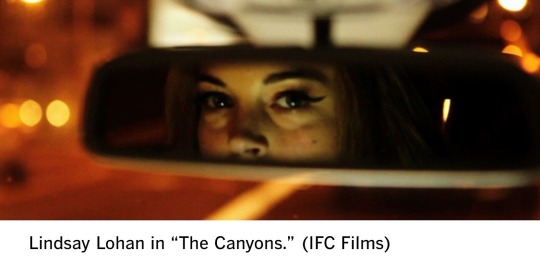
Do you think theaters are going to come back?
Not in the way they did. There are only four reasons for theaters to exist anymore. And this situation has accelerated these trends. Like symphonies and operas and live theater, concerts, they need a reason to exist. One reason is family cinema, because parents love to see their kids interacting with other kids. Animation films will always have an audience. Another is extraordinary spectacle. IMAX, virtual, whatever they come up with. Something you can’t see at home. The third is date movies for high schoolers, which is horror and rom-coms. Or rather, dirty rom-coms.
And then the fourth is club cinema. Which used to be called art cinema. But with these new institutions that are a combination of social institutions and cinematic institutions. So the Metrograph in New York has one restaurants and two bars. There’s more square footage devoted to eating and drinking than there is to watching movies. And yet it’s always full because people want to be in that environment. So then alcohol’s become the new popcorn. And those club cinemas, which were pioneered by Alamo, they will continue to exist because people want to be part of the club, people want to buy a membership. They want to eat and hang out, and they want to know which films have been approved by the club. Which is something you cannot get from VOD.
When “First Reformed” was coming out, you spoke about how you had made it thinking it could be your last film. And yet you seem so reenergized over the last few years. Do you feel that way? Have you been able to hit the reset button in some way?
Oddly, yes. I’m in the middle of a new script, which is about a horticulturalist. And what has happened in my case, following the disastrous situation I went through with “Dying of the Light,” I said, I would no longer work unless I had final cut. And once I got final cut, I was free. When I began, you didn’t really need final cut. When I was working in the studio system, all those other films, you were working with people who knew movies, who liked movies. Who you can talk to, you could disagree with — things would get changed, sometimes they’d get better, sometimes for worse in your mind, but you were working with people who liked movies, who watched movies. In the last 15 years, I’m dealing mainly with financiers, who not only don’t watch movies, don’t even particularly like them. And how can you have discussions with these people? And that’s what final cut freed me from, because I realized I couldn’t talk to these people. I wasn’t talking to [studio executives like] Barry Diller and Thom Mount and Ned Tanen anymore. I was talking to Joe Schmo from some hedge fund and I couldn’t talk to Joe Schmo. The only way I could talk to him was to have final cut.
I’m certainly excited to see what becomes of “The Card Counter.”
The new one is quite good. Focus told me not to hump it too much because that’s their job down the line. But you can take my word for it, it’s quite good.
###
#paul schrader had to convince oscar isaac to shave off his dune beard 😂#oscar isaac#william tell#the card counter#paul schrader#tye sheridan#willem dafoe#tiffany haddish#covid-19#coronavirus#focus features#dune#dune 2020#first reformed#the canyons#taxi driver#interview#los angeles times#la times
85 notes
·
View notes
Text
the history teacher // rengoku kyojuro
Author’s Note: I couldn’t end with the Rengoku angst from before sighhhh. I had to write a part 2 because ugh it was killing me. I want this precious baby to keep smiling and even if it was a bittersweet happy sort of end I wanted him happy happy. So here. Hope ya’ll like this, and thanks for the love!
Word count: 2768
Pairing: Modern! Rengoku Kyojuro x Reader
Warnings: pining, mentions of death, spoilers for manga, fluff

❝
If there was one word that described Rengoku Kyojuro as a teacher, then it’d be... eccentric.
Yes, it’d be eccentric because he was well known for his odd ways of teaching and inflicting knowledge on to his students. History was one of the subjects many students hated (even grown-ups, for that matter, don’t recall history with fondness). With someone like Kyojuro on board, the school definitely hit a goldmine.
Rengoku loved history, and perhaps, because of his added eccentricity, it became a must for him to put two and two together and have his students see what history actually meant. It was fun learning how the world worked until that point, and there was so much energy in learning the theory of it all that Rengoku knew exactly what to do for each class. His passion never failed his students, and that was something even the students appreciated.
He never picked favorites. He never compromised, yet, he would always understand when something was too much. He could read the expressions on his students’ faces like the words off a book, and that was one of the best skills Rengoku had as a teacher, and definitely not his last.
However, if he had to pinpoint what Rengoku’s negative traits were, then it’d be one thing and one thing only.
He wasn’t great with women.
It was as if he was healing from a past flame but he was the textbook definition of shy when it came to them. Rengoku could speak to them as colleagues, as friends, as students, but the second someone implanted the idea of a ‘date’ in his head, the words would leave his system, his eyes would look everywhere except on people, and his fingers would turn tingly at the edges. It wasn’t as if he hated women or that he knew he wasn’t going to do well with a woman, it wasn’t any of the regular fears that men had.
It was as if even looking at another woman was cheating.
He never realized who he was cheating on—because that didn’t make sense. And this wasn’t always the case either. When Rengoku grew out of his teenage years, his interest in other women reduced drastically. As a child, he did have crushes, he had first loves but they never exceeded to a relationship and he was left wondering if something was wrong with him.
Rengoku, however, was incredibly happy being single—and if sometimes felt like he wasn’t single at all. He never felt alone, strangely, and he never felt an overwhelming desire to meet anyone. He felt content; as if anything that had to happen would happen and the mere idea of pondering was too foreign. His colleague, Mitsuri, often trudged him into meeting other women, and initially, Rengoku agreed. But, the dates were so bad that he eventually gave up.
Whoever his heart was waiting for, or whatever this was, would eventually show up.
What a hopeless romantic.
*
After class that day, Rengoku walked home quietly. He had a soft smile on his face and he noticed that it may rain. Being as well prepared as he was, he was equipped with an umbrella, but he had a feeling he’d catch the bus before it poured. On reaching the bus stop, in less than a minute, the rain caught along—a soft chuckle escaped his lips as sat at the bus stop, alone, thinking of dinner.
He could hear a patter from not too far, causing him to turn his head toward the source of the sound. Someone was running toward the bus stop, with a bag over their head. As soon as this person reached, she sat down on the bench next to his and breathed heavily. She was a bit wet from the rain, but there was nothing else. Rengoku couldn’t even see her face, she was bowing down from having sprinted from god knows where. He turned and faced forward before something caught his ear.
The woman beside him was now... crying?
Rengoku turned to her and noticed that her hands were covering her face, she was bending down, her forehead was touching her knee, and her shoulders were shaking. She wasn’t a loud cryer, she was sobbing but quietly. Like, the weight of the world was on her shoulders, and she was just getting so tired. He didn’t know what to do, he was a bit confused. However, not knowing who she was somewhat helped in his need to comfort her.
He raised his hand and placed it carefully on her back, patting her a couple of times. She froze for a second, before leaning up slowly, turning to look at him. Rengoku’s eyes widened for a second as he looked into her (e/c) eyes, but he got his composure back. He smiled warmly at her before noticing her lips quiver once more.
A lone tear streaked down Rengoku’s cheek as he watched her. His hand, which was on her back went to her cheek, and there was nothing in the world he wanted more than to just touch her once. Just once and that would be enough. There would be nothing more he would ever need.
His eyes widened at this unfamiliar memory. What was this? Why was he suddenly feeling nostalgic for a time he didn’t recognize?
“You feel warm,” Her voice said, raspily. “I’m sorry I’m crying...”
Rengoku shook his head, “No! Crying is a cleanse! It helps you take away whatever you weighing on you. So cry all you need. I’ll be here.”
She turned to look at him from the corner of her eye before sniffing once. Somehow, when someone said ‘cry’ to her, she lost all reason to. Just by looking at him, a warm happy face, smiling at her, showing her kindness despite being a stranger, made her feel less lonely. And maybe it was because of his kindness, did his eyes seem so familiar.
“Have we met?”
Rengoku suddenly felt a whiff—a scent so familiar it felt like home. His heart ached in such a familiar way, and the very familiarity of it pained him. His hand, which was on her back, now traveled to her cheek.
“Have we?” He asked, his voice merely a whisper.
As if reality pulled them back to where they are, Rengoku and the woman pulled away from each other, shuffling and awkwardness filled the air. He took another look at her before squinting a bit, wondering where he had seen her and why he felt so happy. He felt his heartbeat erratically, imitating the sounds his ears would make after running 15 laps in the morning.
It is as if, oddly, he was waiting for someone but he didn’t know who they were until she arrived. He was always hyperaware that there was something missing in his life, and somehow, with her entry, it seemed complete.
“You were crying. Are you feeling better now?” Rengoku’s voice alerted her.
She smiled a bit, shooting his heart to the skies, “I feel a lot better. Thank you, uh...”
“Rengoku Kyojuro! I’m a history teacher at Kimetsu Academy!”
She giggled, confusing him.
“Did I say something funny?”
She shook her head before saying, “You’re filled with so much energy! It’s nice to see.”
There it was, once again. He didn’t know anything about her yet her face told him things he was so glad to know. For some reason, Rengoku knew that the very next words he’d say, he had said a long time ago. A time not from now. A time he didn’t even know had passed.
But, he had said them. And he had said them to her.
“I’m glad my energy could make you happy.”
He suddenly felt an overwhelming desire to cry, and he wasn’t certain why. Just by looking at her, sitting beside her, having seen her cry, made him feel things he thought he had felt before but had never felt in his waking life. What is this? he questioned himself repeatedly, but perhaps, that was what he was doing wrong.
Perhaps, he wasn’t supposed to question anything. All his life, he felt like he was waiting for something, for someone, and here was something that felt so familiar with no reason—and he was questioning it again. Shaking his head, he smiled warmly at her, having her blink.
“My name is (l/n) (y/n). I’m going to join as a teacher’s assistant at Kimetsu Academy too.”
Rengoku smiled, nodding once.
“I am glad you’re feeling better now, (l/n)-san.”
“All thanks to you. Really. For helping out a stranger who just broke out crying like that—”
“We all rely on the kindness of strangers, (l/n)-san. I am happy that I had the chance to show kindness to someone else. It’s a great feeling!”
(y/n) looked at her and smiled. He felt so warm. Like a winter fire.
“Also remember,” He caused her to blink. “If it doesn’t matter in five years, then it doesn’t matter.”
(y/n)’s eyes widened. He didn’t ask her why she was crying, he didn’t ask her what it was about. He didn’t care to know more than what was necessary and yet, he was trying to help her. It was strange how soft this felt and how his kindness moved her to tears, but the mere fact that it had made her heart warm.
“Thank you, Rengoku-san.”
It was perhaps the way she called his name did he confirm his theory. He knew her, perhaps in a previous life. Perhaps, in a previous life, he loved her—but they could not be together. Perhaps, their story was one that dragged on for centuries before the right permutation hit and they could finally be brought together. He turned to look at her once and once again felt that strange familiarity.
(y/n)-san.
Rengoku felt as if he had dreamed her up before he met her; not out of nothing—nothing comes of nothing—but out of an earlier encounter, both true and wished for. He recognized her with such certainty because he already, in a certain sense, knew her; and because he had quite literally been expecting her, he felt as though he’s known her forever, and yet, at the same time, she was quite foreign to him.
They were familiar foreign bodies.
*
With time, Rengoku found it strangely odd how much he wanted to talk to her. He watched her eat, speak, read and even sometimes, watched her teach—and she was such a blissful person. He couldn’t be rude to her, no one could, and there was something so mildly attractive with her flaws that turned his head inside out.
Mitsuri knew of his growing attraction to the teacher assistant and was incredibly happy that her friend was finally facing a woman. However, there was also an odd sense of familiarity that even she sensed, which didn’t go unnoticed.
“Do you know her from somewhere, Rengoku-san?” Mitsuri asked, cocking an eyebrow.
Rengoku laughed once, “It feels like I’ve known her all my life, but I only met her a couple of months ago!”
Mitsuri found that odd. Suddenly, being the romantic that she is, she clapped her hands together and hummed loudly—causing Rengoku to merely blink at her, confusedly.
“Kanroji—”
“Rengoku-san!” She was twirling on her spot, “I think you were lovers in a past life!”
Rengoku blinked, unsure.
“What makes you say that?” He asked, tilting his head.
“For starters, the way you look at her feels to me like you’ve been watching her for a long time. You smile so... calmly at her, like you’re so, so in love with her and this isn’t something a few months can do! And not to mention—” She squeaked before saying, “Not to mention the familiarity! That can’t happen so fast, either!”
Rengoku nodded, taking mental notes.
“Can you describe it to me?”
“The first time I saw her, she was crying. As if something terrible happened. I never asked her why, but just looking at her cry made me feel terrible. As if I had caused it. As if I’ve caused it before.”
“Oh, Rengoku-san! That’s... That’s—”
“And, there was a whiff of a scent. Maybe it was the perfume she was wearing, but it felt as if I had smelled it a long time ago. And when she complimented my energy, it felt as if she had already done it once before. A deja vu sort of essense—”
“Rengoku-san! You have to tell her!” Mitsuri now looked furious.
“Tell her... ?”
“You have to tell her you love her because from the looks of it, you’ve been in love with her your whole life!”
Rengoku never denied being in love with (y/n), and maybe that’s why Mitsuri thought he was a romantic as well. It wasn’t that, at all. He simply believed there was no point hiding something as obvious as that, there was no need to. It was as if someone was trying to hide the color of their hair or skin, or trying to hide that they had teeth.
There was no use in hiding what was obvious.
(y/n) was eating lunch alone that evening. She was late in submitting some documents that converted her from being a teacher’s assistant to a proper teacher, and she decided she would eat only after she completed the work. Now that she had, there was no one she could eat lunch with, so she sat alone on the terrace—recalling her childhood—and ate her bento.
“(y/n)-san!”
He was overjoyed when she had asked him to call her that a few weeks ago. It once again felt so familiar—he even noticed it the way she carried herself. She didn’t feel closed off, and he wondered if he was the only one feeling this.
(y/n) turned and felt her heart skyrocket at the sight of her favorite history teacher.
“Rengoku-san! Good evening.”
“This is late for lunch,” Rengoku said, joining her. “But, I shall join you.”
She smiled before eating her lunch quietly, enjoying his presence.
“I wish I had a history teacher like you, Rengoku-san,” She chuckled, “I didn’t like history as a child.”
“That’s you and so many others!” Rengoku laughed.
“I’m sure you’re very good, I’ve heard from the students how good you are. How passionate you are about the subject. Warms my heart at how you use your energy in class. Your students are very lucky—”
“I love you, (y/n)-san.”
“I love you, (y/n). We will meet again.”
Her eyes widened at his words. Suddenly, there was fire around him—almost blinding him from her and he was suddenly wearing a black uniform—strange yet so familiar.
“R-Rengoku-san?”
Rengoku chuckled before leaning forward, their foreheads touching.
“I think I said we’ll meet again.”
Her hands clung to his cheeks and she held him like her life depended on it. Tears were streaming down her face and she sobbed, but she didn’t know why.
“Rengoku-san!” She said, pressing herself to him, his hands slowly wrapping themselves around her fragile form.
Pulling away, Rengoku pressed his lips to hers, burying his fingers in her hair. She kissed back just as fervently, her hands moving to his neck and her bento forgotten on the ground. He pulled away a bit before pressing a soft kiss on her lips before kissing her cheek and then her neck, peppering kisses all the way, kissing her as if he had missed the chance to do so long ago.
If they remembered what it was, it would break them.
The two of them pulled away after a bit before staring into each other’s eyes. Rengoku smiled warmly as if he was more than happy with his accomplishment, and she chuckled.
“I’ve always wondered why I kept waiting for someone.” He said, rubbing a thumb across her cheek.
“Waiting?”
“I discovered that I found a lover when I saw you cry for the first time!”
(y/n) pouted before hearing him laugh once, kissing her nose.
“I can’t stop touching you...” He whispered, their noses touching.
There was no light attempting to take him away this time. She was here and so was he. And she had seen his love for her, just as he had seen hers.
“Don’t you have class?” Rengoku asked, blinking a couple of times.
(y/n) blinked once, before pulling away, screaming. Rengoku silently packed her bento as she ran down, however, just before heading down, she paused. She turned around and grinned at him, her eyes closed.
“I love you, Rengoku Kyojuro. History teacher. Love of my life!”
Rengoku’s eyes widened.
Ah.
There it was.
❞
#rengoku x reader#rengoku#rengoku kyojuro#demon slayer rengoku#rengoku kyoujurou#rengoku x y/n#rengoku kyojuro x reader#rengoku demon slayer#demon slayer#kimetsu no yaiba#kimetsu no yaiba x reader#kimetsu no yaiba spoilers#kimetsu anime#rengoku kimetsu no yaiba
318 notes
·
View notes
Text
Please Don’t Sleep on Hades

2020’s…been a real year, huh? At a time when in-person gatherings aren’t much of a thing and people have to stay in, video games are suddenly a pretty attractive option. That said, few games have really grabbed me this year; in a roundabout way, 2020’s been a year of reruns, as I go through a lot of games I’ve already played or games that are just yesterday’s news (but new to me!). However, in the nick of time, the folks at Supergiant Games delivered unto us their latest title, Hades. While they’ve been working on this game for years, with it hitting Early Access on Steam back in 2018, the full version of Hades finally hit Steam, the Epic Game Store and made the leap to consoles with the Switch, which is where I picked it up. It has been a WHILE since I’ve had a game grab me so strongly so early on, and I’ve been hearing this game’s praises for years now already, so allow me to happily state why I think Hades is worthy of the hype and is a fantastic game I’d easily recommend!
DADDY ISSUES
OK, so first things first…you don’t actually play as Hades in this game, but rather his son Zagreus. Ol’ Zag has had it with his father, and tries to literally fight his way out of hell to reach the surface, and no matter what his old man puts in his way, Zagreus (and the player) will meet the challenge. And probably die, but hey, that’s OK! In the underworld, death is more of an inconvenience than anything else, so after taking a moment to dust himself off, Zagreus will head out for another attempt. For as long as it takes.
Hades is a rogue-like, meaning it’s a game based around randomization and adaptation. On any given “run” of the game, the level layouts, enemies present and the variety of power-ups Zagreus can find will be left to chance, with the player challenged to amass the best build they can to eventually break out of hell and reach the human world and if you die…start from scratch. That said, Hades is among the ever-growing sub-genre of rogue-lites, in that there IS some permanent progression, which takes a bit of a sting out of dying, but more on that later. Now, most games of this type aren’t really big on story. They have a premise that’s little more than an excuse to play. Splunkey wants you to explore a cave, The Binding of Isaac sees you escaping a basement and in Enter the Gungeon you uh…e-enter the gun—you get the point! But what separates Hades from most rogue-likes/lites is that there actually IS a very interesting story that unfolds as you play.
There’s more to Zag’s desire to get to the surface than just getting away from his father, though their strained relationship certainly doesn’t help matters, and over the course of your many, MANY escape attempts, players learn of the rather screwed-up nature of Zagreus’ family of deities, though any mythology nut could tell you to expect that. Hades has an incredibly charismatic cast, superb voice acting across the board, and some real sharp writing that really got me wanting to meet anyone and everyone and learn more about this world. You’re likely to run into Hypnos first, who always has a “tip” ready for you when you meet your end to a given enemy or hazard, or the fabled hero Achilles, who acts as a mentor to Zagreus. There’s Dusa, the adorably frazzled flying gorgon head who acts as the House of Hades’ maid, and of course…Megaera, of the Furies.
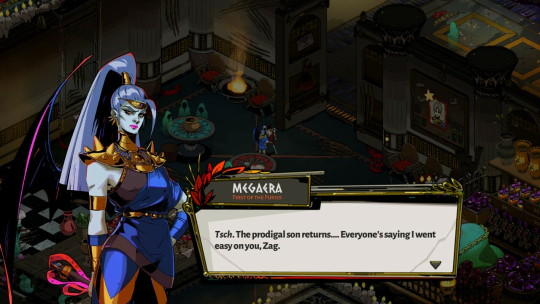
She serves as the first proper boss in the game, and will be a pretty sizable challenge for most players, but as you eventually overcome her again and again, she and Zagreus end up attempting to reconnect with each other, and her recurring fights become an excuse to flirt and test each other. I may as well say too that it’s easy to fall in love with the characters in this game because…I-I mean, just look at them! This game is a bisexual’s paradise, that’s all I’ll say.
A bit of a fun fact, but Zagreus’ voice actor, Darren Korb, is also a composer at Supergiant, so he’s a man of many talents, since Hades has a killer score. From the laid-back tunes at the House of Hades where you can unwind and recharge after a botched run, to the pulse-pounding boss theme, there’s some GREAT music on display here. And that’s before you meet Orpheus and Eurydice, two characters with amazing singing voices that, if you play your cards right, might start singing together. The game’s visuals, meanwhile, aren’t a slouch either. While the level layouts are randomized, everything manages to look well-crafted, each region of the underworld having their own distinct look and feel. The fiery pits of Asphodel end up juxtaposing well with the paradise that is Elysium. Now, character models are generally less-detailed since the camera stays zoomed out to give players a good view of the action, but the portraits for the various characters more than make up for it with their distinct, detailed designs. A-And I’m not just saying that because everyone’s hot! Now, admittedly you might take a look at Zag and think he’s nothing but an edgelord and the game itself might be taking itself too seriously, but in reality, Hades strikes a pretty good balance, and definitely carries a sense of humor. Characters love to snark at each other, the various Shades chilling in the House of Hades’ lounge have some funny conversations you can listen in on and all told, the game only gets serious when appropriate. Really, I have no real complaints with the game on a presentation level; it’s all aces so far, and thankfully the game-y part follows suit!
LIVE.DIE. REPEAT.
Hades is best described as a dungeon-crawler. You have an isometric view as you move about, avoiding hazards and fighting off enemies as you climb each chamber on your way to the surface. Defeat every enemy in a chamber and get a reward. Sounds simple enough until you factor in all of the various permutations of events; Hades aims to make sure no two runs are alike, with different enemies, power-ups and challenges awaiting you. All of this is doled out slowly, as with each subsequent playthrough you begin to have more of the game unraveled. First and foremost, Zagreus can gain various Boons from the other Olympian Gods, who are sympathetic to his plight and lend him some power if he makes contact with them. Each God has their own twist on the abilities they grant Zagreus. They can all increase his stats in some way, or affect either his dash ability or his Cast, a projectile attack. For Zeus, naturally, all of Zagreus’ moves will gain an electric effect, whereas Artemis focuses more on upping Zag’s critical hit chance. Dionysus, the God of Wine, grants you the “hangover” status effect, allowing your attacks to uh…make enemies drunk? Sure! You’ll be given a random selection of three Boons to pick from, of varying rarities. Over the course of a run, you might try to nab as many Boons from the same God as possible, or vary it up and see which abilities synchronize together. At times, you might even be granted a Duo Boon, where two Gods decide to combine their power for a special ability that plays to both of their strengths. Still, at other times, you might be forced into a Trial of the Gods, where you must choose one God’s Boon over the other, with the snubbed God lashing out afterwards. Hey, just because they’re Gods, doesn’t mean they’re nice. Of course, you’ve also got a variety of health and weapon upgrades too. In fact, let’s gush about the weapons for a second, shall we?
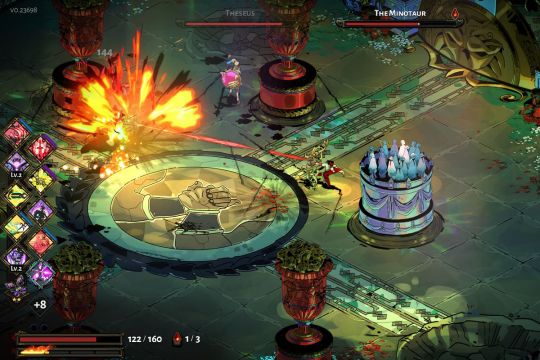
At the time of writing, Hades has six weapons to play with. You start with a sword, which is the all-rounder of the set, but as you gain keys to unlock more weapons, you can start to really experiment. The bow and rail cannon serve as ranged options with different approaches, while the spear is the melee weapon with the best range at the cost of pure power. The shield grants you absolute defense at the cost of range, while the gauntlets let you unleash your fisticuffs on underworld scum, though leave you with limited ranged attacks. Each weapon has specific Boons and weapon upgrades you can find as well, some of which can radically alter how a weapon works. The rail cannon, for example, fires a lot faster than the bow, but this is balanced by needing to manually reload…unless you get a weapon upgrade that gives you unlimited ammo with the only catch being that you can only do burst fire. Adding to this, players eventually unlock hidden Aspects of weapons, morphing them into different forms which can also influence their moveset. Change the shield to the Aspect of Zeus, and when you throw your shield Captain America style, it stays out and continually spins, dealing tons of damage over time and effectively forcing enemies to get sliced to bits if they want to get near you. I didn’t expect this game to have half this many weapons or to have them balanced so well. Really, just like anything else, weapons are another tool you can poke and prod and experiment with until you get a truly killer collection of Boons and upgrades that let you just demolish anything in your way. It’s very satisfying when you finally clear a run with a great build…though depending on the RNG, you WILL get some crummy builds, but that’s the nature of the rogue-like!
It’s likely that a bad build (or really, just getting hit with a new boss or enemy you aren’t prepared for) will lead to a death, but as already established, death isn’t really that much of an inconvenience in the underworld. Zagreus just spawns back at home and is free to immediately try to escape again, but this brief reprieve lets you chat up whoever happens to be around, give them gifts, advance some side-quests, pet your dog Cerberus and practice with weapons and such before you’re ready to go at it again. It’s after a run that you also get to spend a lot of the spoils of your escape attempts. While you lose Boons and weapon upgrades and the like upon death, there’s a LOT of various items you keep with you that have plenty of uses. Darkness shards are used for permanent skills that can be applied to Zagreus, like Death’s Defiance, which grants Zagreus another life upon dying, which can eventually be upgraded to give him THREE extra lives, just as an example. Precious gems can be used to fund a variety of cosmetic changes to the House of Hades. Just because Zagreus doesn’t want to live there anymore, doesn’t mean he can’t at least make it look good! Nectar can be gifted to other characters to improve your relationships with them, with bottles of Ambrosia being required later on, while special keys can be used to unlock weapons, more upgrades for your Darkness shards, or just used as a secondary currency for trade. There’s really a LOT of different items to mess around with, though admittedly if you’re the type to want to max out EVERYTHING you’ll be in it for the long haul, as there is not only a LOT of stuff to upgrade and purchase, but the random nature of things means rewards are never a guarantee. Though it’s worth noting the game’s totally beatable without going nuts with completion. Which I guess leads me to the biggest compliment I can give this game: even after “beating” it, I still can’t stop playing, and there’s plenty of reason to keep going.
REPLAYS AND REWARDS
So, full disclosure, I’ve gotten Zagreus to the surface. Several times, actually. But I haven’t quite “beaten” the game yet. In fact, at the risk of sounding pretentious, it is as if the true game begins after you’ve beaten it once. Without getting into specifics, let’s just say the game gives you a very good in-story reason to keep playing, and you won’t reach credits without several completed runs under your belt. And even then, there’s still stuff to do. I’m almost 30 hours into Hades and I’ve barely scratched the surface honestly. Every major character has their own sidequest you can undergo, but it can be slow goings when it comes to advancing them. Trying out all the weapons and boons and different combinations will easily take dozens of hours to fully experience, though the game has a handy in-game list of what you’ve done and haven’t done, as well as in-game achievements with tangible rewards that will spur you on. I was admittedly surprised at how dense of a game Hades can be. A successful run will likely take you somewhere between a half-hour to an hour, which is pretty devious. Just long enough to stay engaging throughout, and short enough that I can keep convincing myself that I have time for “one more run” and then suddenly several hours have gone by. Strangest thing.
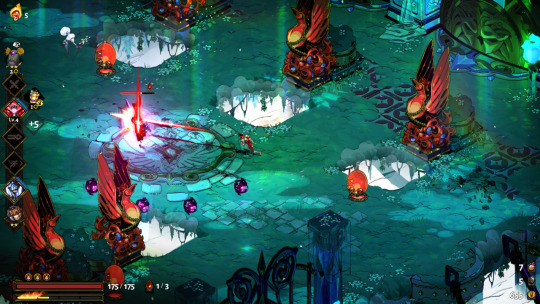
Something that’s become a bit of a staple of Supergiant’s work is customizable difficulty, various modifiers you can flip on to make the game harder if you so desire, which in Hades takes the form of the Pact of Punishment. After a successful run, you can turn on a given pact to spice things up for subsequent runs. Maybe enemies do a bit more damage, or you give yourself a super strict time limit to clear a run. You can give enemies armor that makes them sturdier, or jack up the in-game shop’s prices. You can even be forced to give up Boons in order to advance past certain doors! Probably the most impressive Pact is Extreme Measures, which ends up greatly affecting the boss fights in the game…trust me when I say you won’t be ready for them the first time you flip that on. Activating a given pact increases a “heat gauge” that, should it reach a given level, will end up granting you various special items to help with fully upgrading and unlocking stuff. Of course, with each successful run completed with a given Pact activated, you’ll have to raise the heat more and more in order to keep getting these upgrade materials so be prepared. You can also still gain these materials (albeit at a much slower rate) playing through the game normally though, and there’s really no penalty for choosing NOT to activate a given pact. On the flip side of things, there’s also a God Mode you can toggle on that makes Zagreus a little stronger with each death, which can help those that want to see more of the story but are struggling with the game. Have your God Cake and eat it too!
All and all, this game just delivers on every level and I’ve been devouring it since release whenever I have a spare minute. You can see that Supergiant is taking all the lessons they learned from each previous game and combined it to make what is easily their best game yet. I don’t throw around words like “masterpiece” lightly, but Hades is just such a slam dunk that I’m sorely tempted to call it just that. I mean, if you hate rogue-likes, I’m not sure if Hades will really push you over the edge admittedly? You get way more rewards retained after death than just about any other rogue-like I’ve played, but if you’re the type that hates having to constantly adapt and not being able to memorize what’s coming, I can see this not working for you. But for me at least, I’ve had an absolute blast with the game and the only issue I really have with it is a small nitpick at best. When it comes to getting to know various characters, you can talk to them and give them Nectar or Ambrosia as a gift right? But what happens if they don’t show up on a given run? Or what if they DO show up, but they’re locked into a conversation with someone else? That means you can’t really advance anything with them until a given dice roll pities you. MEGAERA I THINK YOU’RE COOL, PLEASE JUST TALK TO M—oh sorry, don’t know where that came from… So yeah, that’s the nittiest of picks.
I adore this game’s cast, the voice work and music is excellent to the ear, the combat is engaging, the gameplay loop is addicting…need I say more? I mean, I’ve said almost 3000 words, but to really sum it up…I highly recommend Hades and I hope you don’t pass it up if you’re even remotely interested. You can find it on Steam, the Epic store and Switch as of right now, and I don’t think you could go wrong with any version.
Blood and darkness await you.
-B
#Hades#Hades game#supergiant games#hades supergiant#zagreus#megaera#rouge like#nintendo switch#xb-squaredx
7 notes
·
View notes
Note
It's interesting how people can understand Poro even though they don't speak english or any other language other than Poro.

Is silly! Poros speak poro! Is very simple language!
In fact, one could learn to speak poro, or at least, learn what poros are saying, since poros can understand most languages but most people cannot make chitter sounds like poros. Of course, poros also speak a lot through movements, because are simple sheep puffs.
I’ve actually written about poros and language before as a headcanon, but I’ll try to be brief. Basically, poros don’t have proper nouns. This might seem confusing to others, but it’s because for a long time poros did not have any reason to have such things. Everything was either a poro, a snuggly not poro, or a not-snuggly not poro. Pretty much all things can be divided into these three categories.
Of course, as poros began to interact with the outside world, or more accurately, the outside world came to interact with poros, poros began adding words to their language to describe things. For example, poros have a basic understanding of what a ‘human’ is. It’s a two legged non-fluffy creature, but it can be snuggly. This is why poros often describe various beings as ‘x human.’ Thus, xayah and rakan are bird humans, neeko is lizard human, and nidalee is cat human. If there is nothing else that could describe them, poros might use something they have, like say, ashe is arrow human, or sona is sound human.
The exception to this rule is when poros find a friend, or develop a specific relationship with a creature. Thus, Braum is Braum, friend of poros. ‘Friend of poros’ is the actual canon title he has, apparently bestowed upon him by poros. So extrapolating from that, poros tend to only add things to their language when it is encountered, and their society adapts thusly.
For example! Poros have a king! Is Poro King. But what is a ‘king’ to a poro? Poros observe that a king, based on their understanding, happens to be the most thing of something. Thus, a human king must logically be the most human human! They may have gotten this idea from looking at Tryndamere. In any case, the Poro King is most poro-y poro! Is most snuggly and most soft and biggest! Is logical to poros.
Some poros do have names! Though not all poros. Usually, a name comes about because humans like naming things, and poros tend to adopt the names that humans give them, or at least, usually they do. Not always. But poros don’t think of themselves as being named, but they use a name because it helps other creatures understand.
Poros thus communicate through chittering, usually based on tone, and of course, movements, usually snuggling. Poros love snuggling. They snuggle for hello, goodbye, to decide things... everything.
In fact, I’ve joked before that poros are a bit like Ents in Lord of the Rings; if you asked them to decide something the poros would come together and form a snuggle pile, and after four days you might discover that the poros have decided that they need to come together to discuss something. Poros, after all, are easily distracted.
Now, humans could probably learn to interpret poro chitters, or at least, the sounds poros make, to refer to things, because again, most things are not named in poro. Most things are poros, not poros but snuggly, or not snuggly not poros. Things that are important are thus named, and they are few and far between. Poro snax, for example, are named. But then, poros often refer to food in general as poro snax, and so humans might interpret poros making the sound to mean ‘food.’
So most of the time, poros do not communicate complicated things. Poros are simple sheep puffs, made of kindness, valor, and innocence. Do not exactly have too many complicated ideas or thoughts to express most of the time. So one could probably learn to understand poros, even though they can’t speak it.
It also helps that poros do not understand reading or writing, and thus their language has no permutations that come with trying to spell anything. Poros find human fascination with the squiggles in the paper rectangles to be silly rather than useful.
Another thing that helps is that poros are sentient, in that they are capable of thinking and quantifying things, though this is obviously quite basic. The difference between sentience and non-sentience can be boiled down to ‘is this creature capable of quantifying things?’ Example, a dog might understand that it likes this food more than that food. But it isn’t going to grasp that this food is entire different than this other food. They’re just both food. Whereas we might divide chicken and beef into entirely separate food groups within them being food, a dog just knows that it is food, and it might like one over the other. There’s no mental grasping that there might be something inherently different about it. Another example might be that a sheep likes the grass on one side of a hill more than the other. But that’s as far as it’s mind will go. It won’t understand why the grass over there is better, or all the factors that go into it being better. It just knows that it likes it there more.
This is why we can hear music, and understand things like beauty, subjective things, that animals and non-sentient creatures can’t understand.
Poros, therefore, are rather simple, somewhat crude in their understanding, but sentient. They can understand subjective concepts to some degree, like whether or not creature are or are not snuggly. But that only goes so far; they can’t grasp things like music yet, or writing; to poros, writing is just squiggles and they don’t seem to have much meaning.
All of this feeds back into language. Humans might, with time, understand poros, because poros are simpler than humans. Understand how poros think, understand poros. Poros however, cannot really grasp humans, but they do understand human languages intrinsically, due to an entirely unrelated part of poros, which I’ve discussed at length before about the concept of ‘collective belief.’ Think the World of Darkness ‘reality paradigm’ or Warhammer 40k’s Orks making things true because they believe them. Poros operate much the same way. Poros believe that they understand humans, so they can, even if they do not understand all the words or what they mean. It’s this ability that keeps the great old one that turned the Freljord into a frozen wasteland under the ice, because poros believe that it is under the ice, and thus it will always be so. This is also why Braum is immortal, because Braum is friend of poros. Thus, he is always friend of poros, in the present tense. Poros do not really distinguish tenses well.
Essentially, poros being simple allow this all to work. If poros were more complex, the large variance of thought would change the reality paradigm and thus they would no longer exert that sort of collective belief over themselves and reality, as they were created to do by the gods to keep the great old one and the void away.
And all of that is understood in the poro’s language, which is simple and straightforward, much like poros themselves. And now you have my simple anthropology essay on poros and how they speak.
16 notes
·
View notes
Text
hellsingmongrel replied to your post “I just realized something… Maybe God has acknowledged that Crowley is...”
Honestly, my headcanon is that God knew she would need them together, fighting against their opposing sides in the end, so Crowley didn't particularly Fall, he was PUSHED. On a personal level, it seems cruel, but she knew he and Aziraphale would be happy together, in the end, and Crowley's suffering would mean that the rest of the world could saved from the Armageddon. In the end, it was the kindest option for everyone, Crowley included, even if he doesn't know it.
This leads into something I’ve been thinking a lot about: the question of free will of the characters versus everything being according to God’s “Ineffable Plan”.
Personally, I think another word I’d use to describe God’s plan aside from “ineffable” is “fluid”. It’s not static. It changes with each action, each decision, and each outcome.
And yes, this is still compatible with Free Will. There does seem to be this pattern of God setting up the choices and then people making them. Then God adjusts Her plans accordingly which leads to the next set of choices. There’s contingency after contingency set aside for every possible permutation of decisions made due to free will. Thus, it truly is an ineffable plan because of the sheer complexity involved with having a plan that is both dynamic and goal-oriented.
In that sense, Aziraphale was right. There has to be choices, that is at the core of the Ineffable Plan and is the intent behind God’s directives. He was mistaken, however, in thinking that this plan only applied to humans....
Because, I think God extended Free Will to Her servants in Heaven as well. Some of them used their Free Will to focus on obedience and strict adherence to God’s commands (in the letter of them if not in the spirit) and would include people like Gabriel, Uriel, Michael, etc. Others decided that their own will gave them the right to decide what is moral and “good” without anyone else’s input which is why Lucifer, Beelzebub, Hastur and their lot decided to stage a rebellion on Heaven (and ended up Falling).
Then you have Aziraphale and Crowley. Two people who demonstrate that God didn’t have a straightforward plan for all of Her celestial children.
My thought is that Crowley should be considered a bit of the classic Unreliable Narrator. Is he the sort of malevolent evil that Hastur or Beelzebub embody? No...but I don’t think he was completely innocent either. He says that he “only asked questions” or “only hung around the wrong people”. But I think he has a blind spot to his very real flaw of carelessness. He does things, sometimes brilliant things (well, brilliant in the sense that he’s good at his job), but he relies more on his wits to smooth out any difficulties rather than thinking carefully about the consequences of his actions beyond his immediate goal.
It’s why he gets foiled by his own demonic plots such as taking down the phone system (making it harder for him to get in contact with Aziraphale when he needed to) and the plot for the M25 (making it harder for him to leave London later on...not to mention the grand scale suffering humans experiences versus the low levels of bad vibes he had planned on). This even extends to his relationship with Aziraphale where he makes the (unintentional. granted) mistake of giving the most backhanded compliment he could (”how can someone so clever be so stupid?”)....which is the exact same sort of terrible treatment Aziraphale gets from Heaven All. The. Time.
This is why Crowley simply could not stay in Heaven. A being who is supposed to act as God’s agent cannot just “wing it” for the sake of getting things done with no thought of how they are getting done. I agree that Crowley did not so much Fall as Saunter Vaguely Downwards because he was never going to be able to direct his free will into complete submission. It is cruel in some ways, but forcing Crowley to squash the qualities that make him not compatible with Heaven is another, worse sort of cruelty.
With Aziraphale...it’s a whole other problem. Because, I think, he does have questions and did have them all along. I firmly believe that is part of why he’s far more welcoming to Crowley than other angels would be. It’s not just because he’s fundamentally good (and tries harder to hold to the spirit of God’s directives than his associates), it’s also because Crowley asks the questions that he thinks a lot about himself. He knows Heaven’s rhetoric for every occasion and will recite it to Crowley, but that doesn’t mean he hasn’t wondered if Heaven is getting it right.
This gets to the heart of what I think Aziraphale’s main flaw is: his inflexibility. It’s a trait that doesn’t attract too much attention in Heaven as long as you’re staying with in the company line. However, it does make things so much more difficult for Aziraphale because, once he decides he is acting in the Best Interests of God, Crowley and all the humans on the Earth, he is extremely reluctant to revise that mindset....even when he makes himself suffer because of it....
Thus, he sticks to rhetoric he’s told in Heaven because he’s decided that God’s Will is good and so he shouldn’t question it. He knows that angels are supposed to consort with demons, so he draws a line between himself and Crowley and won’t allow himself to question if it’s necessary (and in spite of the fact that it’s definitely not what he wants and probably isn’t what he needs).
Even during Armageddon when so much is at stake, Aziraphale is still hesitant to go against everything he’s decided on a long time ago even though another part of him knows that he can’t just do what he’s always done. When he does yield enough to go along with Crowley’s schemes, he makes his own decision about how he’s going to handle it (”I’ll stop the Antichrist from coming into his powers, and if I can’t, I’ll ask the Almighty to fix things.” “I’ll keep up the Agreement, but I’ll also make sure to keep it on my head if anything goes wrong”.) Consequently, he wouldn’t confide in Crowley when he should have and he created far more heartbreak than ever needed to happen.
This is why Aziraphale needed to go to Earth. He simply has too many questions for someone so inflexible and is deliberately, consciously, too soft to execute the unyielding rule of law that Heaven often hands out. Whereas, on Earth (and with Crowley) he can learn about the necessity of not just questioning but also acting on those questions when needed.
Ultimately, Crowley and Aziraphale are the same (questioning the status quo, not really belonging in Heaven or Hell), but also different (one acting recklessly, one too paralyzed to act). They complement each other and are stronger together than apart.
In the end, I agree that it was God’s Ineffable Plan for them to be together and save the world, but they still had to rise above their flaws and act on their own free wills in order to get there.
20 notes
·
View notes
Text
You Asked, I Told
Hello, everyone! I will have another 20k chapter of Baghdad Waltz posting tomorrow, but in the meantime, here are answers to some intriguing Asks you sent me.
CW for some discussion of sexual assault. Spoilers for BW through Chapter 34.

Oh, thank you so much! I love writing these and other secondary characters and giving them life and a backstory that will probably never, ever see the light of day. I have enough head canon to write whole side fics for both Winnie and Rikki. I love Winnie in particular, though I know she can be a divisive character. Winnie has not been a perfect mother, even though (like pretty much every mother) she has tried her best, which is one reason I really enjoy writing her. I usually see Winnie written in fic as either a straight saint or, less often, a villain, so I wanted to give her some more dimension. I will keep up with these characters as the fic continues!
A COUPLE OF SHARON QUESTIONS:

Wow, good catch! Yes, this was mentioned one time back in Chapter 17, when Sharon first disclosed to Steve that she was pregnant. As with many of the things like this that I throw in the fic, it serves multiple purposes.
First, I included this biographical information because of how common sexual violence is — at least 1 in 6 women will be victims of sexual violence in their lifetime. I wanted to also show that a) it can happen to “tough” women, which we would likely argue Sharon is/was, as an Army Reserve Officer attending the University of Virginia, and b) even though she still blames herself (at least to some degree) for “letting” it happen, she’s still an overall well adjusted person who can have healthy, intimate, functional relationships, a successful career, and good self-esteem. This hasn’t ruined her life, and I think that’s an important counter message to have in a fic that’s so laden with characters who suffer deeply and chronically with their trauma. Trauma doesn’t always end in PTSD - in fact, statistically, it usually doesn’t. This will likely come up again later in the fic in another context as well.

Thank you! I’m so glad you’re enjoying the read! As to whether Steve feels trapped by Sharon re: fatherhood, I imagine the details are a bit fuzzy to remember, because it’s been so long since that part of the fic, but I doubt he feels that way. He knows that Sharon has always been lukewarm about the family stuff while he has been dreaming about kids since he was, well, a kid. He knows that she didn’t intend to get pregnant and only got that way because her birth control failed due to an unintended interaction with St. John’s Wort (an herb with antidepressant properties she took to avoid going to behavioral health while he was deployed). As for deciding to keep the baby after becoming attached to it while she was pregnant, despite her previous lack of interest in being a mother, he likely wouldn’t have hard feelings against her for that.
If anything, I imagine Steve probably blames himself for having sex with her while he was home on leave, having just cheated on her with Bucky and not disclosing his cheating prior to having the sex that led to this kid in the first place. Had he told her as soon as he got home, she surely would have told him to go kick rocks, and there would be no Ethan. But he was scared and irresponsible and they were drunk... and now here they are.
And although Ethan certainly feels chaotic and stressful for him because kids can feel that way and because he gets overwhelmed easily, he’s wanted to be a father for so long that he likely sees Ethan as a strong motivator for him to recover from PTSD and the effects of TBI. Certainly a much stronger motivator than Bucky, because in his mind, Bucky can fuck off and cheat on him or abandon him a thousand times over, but Ethan will always be his son. And even though he struggles to be the kind of father that he wants to be, Ethan and fatherhood is at least something very tangible for him to work toward.
Great questions! Thank you!
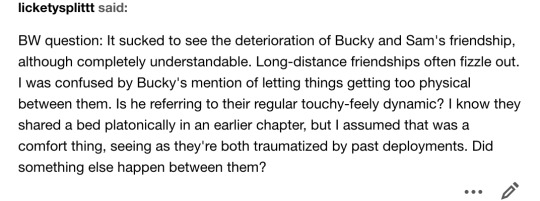
Ah yes, it’s hard to tell what’s going on with their relationship now, because it’s Bucky, who is at times a horribly unreliable narrator. He’s got so much baggage around the Army and not being part of it anymore, and there’s this piece about Sam having the career he wishes he could still have, and Sam having the personal life he could have had with Natasha in some bizarre permutation of reality. And Sam has been deployed, so he’s probably not able to talk much, and Bucky has terrible attachment problems and interprets behavior… not always very realistically. So he might interpret Sam’s distance (logistical, because he’s busy, because they have less to talk about, because they are moving in different directions) as a sign that their friendship was “weird” or that Bucky is “gross” or whatever Bucky is assuming because he’s going through his own shit right now. In short, it’s very possible that Bucky is projecting a lot of his personal stuff onto Sam, like assuming that a pretty normal phase of life transition is actually a sign that he’s being rejected.
But there is a separate issue of Bucky’s friendships getting physical and having these blurred boundaries with friendships. There’s yet-undisclosed stuff in the past that he’s referring to, so unfortunately you can’t see that yet, but he’s drawing on that, and he’s looking at this cuddling behavior (the “snack cake” scene etc.), and I’ll go ahead and say it, since it may never make it into the narrative, but Bucky would definitely have fucked Sam, if he showed even the slightest genuine sexual interest. Bucky has a bad track record with making good friendships in general, and almost all of his close friendships end up getting sexual or para-sexual. Take Steve. They had a pretty intensely physical friendship that got para-sexual and then sexual, and, interestingly, the intimacy that they shared in their friendship also took a nosedive when they really got sexual, but that’s another matter entirely.
So to answer your question, Bucky and Sam didn’t do anything explicitly sexual, but I think Bucky knows he would have, and now that he’s learning about boundaries in DBT, he’s probably wondering about theirs, and he’s looking at these patterns in his life right now, and he’s also just scrambling to figure out why they’re not good friends anymore. I mean, he also really just misses him and the Army, and he’s mourning for both. He’s kind of flailing around here, and that could be another reason why this doesn’t seem to make a lot of sense. But you didn’t miss anything. He’s mostly wrapping himself around the axil over something that may or may not even be a thing. [sigh]

In other words, is Steve a Buckysexual, so to speak? I also am a bisexual person, and I take my bisexual characters pretty seriously (hoo boy). I can see why this might be a big question in people’s minds, because we haven’t seen a very broad swathe of Steve’s sexuality in this fic. He’s very much a monogamist who tends towards longer term relationships, if he can help it (not a guy who does casual fucks well, obvs). We started the fic proper while he was in a relationship with Sharon, then he went to Bucky, and then his sexuality went into hibernation, and now he’s climbing out of that, and we’ve had references to girlfriends in the past peppered along the way.
I’d classify Steve as a late-blooming bisexual. He graduated high school at 16, so he was really coming more fully into his sexuality after he left that environment, and that’s when his interest in Bucky started to fire up. Bucky was the first male he fixated on sexually, which parlayed into a sexual relationship for almost 2 years but then flamed out. Then Steve went into a long sexual hibernation after his mother died and he felt jilted by Bucky’s perceived abandonment, but then he was at the U.S. Military Academy, surrounded by hot young men at their peak fitness and— I will not say more specifically, because this is probably actually going to be addressed in the fic.
But let it suffice to say that Steve is not a Buckysexual. One could also look at the way he fantasized about Bucky in the coffee house to see some clues to his sexual interest in other men. He wasn’t just into Bucky - he was into all these other guys too, jerking off while watching, all the dicks on the wall.... you know. He has had more relationships with women, so behaviorally he would seem to lean more toward women, but I would not say that women are necessarily his default preference. If Bucky were not in his life and they split to opposite corners of the Earth, never to speak again, I think he would be pretty open about the gender of his parter. As long as they let him put their genitals in his mouth, he’d be a happy camper ;)
And FINALLY:

Ah yes, I believe you’re referring to the line “Bucky is still an alcoholic, ‘interpersonally unskilled,’ deeply imprinted from God knows what traumas, and really, who knows how willing to actually change, if change means being honest and shining light in the dark places he’s always kept Steve from, no matter how much he’s begged to see them.” Yes?
So, prior to them separating in 2002, I would say that Bucky and Steve’s dynamic probably went a lot like this:
Bucky was pretty contained on the outside most of the time, with periods where the he was a flaming dumpster fire just beneath the surface and brief episodes where he was dysregulated and really struggling obviously. The latter looked like, say, showing up drunk to Steve’s and saying cryptic things like “I’m disgusting” and sticking his hand up Steve’s shirt… or his post-Ground-Zero “fuck me/I’m totally fucking falling apart drunk” thing, etc. And Steve, after these episodes, was probably like, “You know you can talk to me, right? Please. I just want to help.” And Bucky most assuredly responded with something like, “I’m good thx.”
I think Steve probably suspected for years that Bucky has stuff from his childhood (he would be absolutely dense not to), but I want to say that he probably both wants to know it and is terrified to know it. So his “begging” probably looks like gently imploring in a not too insistent way whenever Bucky does one of these big meltdown-y things. And then when they argue, Steve probably whips out the old, “You keep everything from me! I don’t know who you are! I have to beg you to tell me anything!” because that’s how these things usually go down. And Bucky would never volunteer anything and most assuredly lies about many things overtly and lies by omission alllll the time. So yeah, I would say that this a not-so-reliable-narrator situation but with a strong flavor of truth behind it. If that makes any sense at all.
Thank you so much for the wonderful questions!! What a joy to receive them. More tomorrow.
21 notes
·
View notes
Text
Ranking the Marvel Cinematic Universe, Part 2

If you haven’t heard, there’s some movie coming out later this month that is supposed to be rather huge. In the lead up to Avengers: Endgame, I have been ranking each of the 21 previous MCU films. Part 1 of the list is here: http://ryanmeft.tumblr.com/post/183962601514/ranking-the-marvel-cinematic-universe-part-1 And now for part 2.

15. Ant-Man and the Wasp
Reed’s sequel improves on several key aspects that were lacking in the original Ant-Man. Perhaps the most notable is that this time around, Scott’s relationship with his daughter Cassie feels well developed and not as much like the standard issue plot element it did the first time. His dynamics with Hope and Hank work like a charm, discarding the bit of awkwardness that was there before. We get engaging, sympathetic antagonists who actually manage to add a lot to the plot and provide a couple new characters worth having back. And the benefit of adding Michelle Pfeiffer to the cast cannot be understated.
In other respects, the film is still uneven. Walter Goggins’ addition as a comic-relief mobster doesn’t work, while Michael Pena is still totally wasted on a stereotype. Judy Greer and Bobby Cannavale’s characters have somehow taken a really odd turn and gone from grudging acceptance at the end of the first movie to “people so welcoming it makes you guard your genitals” in this one. Tonal inconsistencies aside, this is a significant step forward that proves the franchise does indeed have legs.

14. Doctor Strange
Here we have the epitome of what, in the days of total control of Hollywood by the big companies, would have been called a studio film. Perhaps no other movie in the MCU follows the guidelines so rigidly: hero is arrogant, hero has something bad happen, hero becomes humble, hero saves the day. Along the way, hero fights evil counterpart and hero has maybe-maybe not relationship with female friend, while losing mentor. It’s screenwriting 101, but does that harm the film? Not really. It works thanks to the committed performances of a great cast, notably Benedict Cumberbatch, Tilda Swinton and Mads Mikkelsen. It’s great to see Rachel McAdams and Michael Stuhlbarg doing almost anything, even if Scott Derrickson doesn’t know what to do with them and awkwardly drops them two thirds of the way through.
The best and most complex character, though, goes to the excellent Chiwetel Ejiofor as Strange’s frenemy Mordo, whose character, in contrast to the simplistic schemer of the comics, has complicated thoughts and motivations of his own not entirely contained by any archetype. The film also gives us one of the best third acts in any superhero film, as cunning, not powers or brawn, saves the day. We could use more of that. All things considered, the “Iron Man but with magic” formula works for the character, but at least until the ending, it also fails to make him stand out.

13. Marvel’s The Avengers
Most of a decade later, the film that showed a superhero team-up could work feels more like a proof-of-concept than a culmination of everything awesome about comics. Let’s start with the main thing that works: the superheroes themselves. Although the film eschews character development, plot hooks, and really most of a story in favor of action, it remains watchable because every possible permutation of interactions between the characters rings true, and their exchanged dialogue zips. Cap and Iron Man are the clash of tradition and progress. Hulk and Widow invert the stereotype of the brainy guy and the dumb woman. Thor is the alien from an outside culture, Hawkeye is the utilitarian badass, Fury is the slightly manipulative leader who bends some rules to get results. Sure, this is all sugar and no substance, and serves only to fuel the fireworks…but it does fuel them. Loki finally comes into his own, too, with this being the film that made Hiddleston’s portrayal really popular. While his genocidal character seems at odds with his more complex motivations in Thor (to the point where fans have speculated he was under some kind of mind control to be revealed in Endgame), there’s no denying that as a tyrannical, worlds-conquering god, he works perfectly. While that final showdown drags a bit in retrospect---like the battles in Lord of the Rings, even the best CG wars are only engaging so many times---the fight between Cap, Iron Man and Thor is a great excuse for that classic comic trope of misunderstood heroes fighting each other..
There’s nothing wrong here, and there’s nothing spectacular or standout, either. It’s basically Marvel and Joss Whedon going “Look, this will work, really” and then the MCU moves on to do bigger and better things with it.

12. Guardians of the Galaxy
There were so many things that could have gone wrong, and so many that did not. Starting with a tight and genuinely funny script from James Gunn, through a perfectly selected cast that made the incredibly difficult feat of expert comedic timing look easy, the Guardians somehow affected a devil-may-care vibe that by the end of the movie had given way to the beginnings of an actual family. Every joke clicks, every elaborate, multifaceted action sequence sings, and Benicio Del Toro’s cameo may be the most delicious in the entire MCU. If the movie falls off from other entries (and its own sequel) a bit, it’s simply because the villain is about as interesting and intimidating as Donald Trump playing golf. Ronan just never feels right, always coming across as a stock character from a bad play, especially since he’s in the same movie as the first decent look we get at Josh Brolin’s Thanos. His two sidekicks are mostly a waste of Djimon Hounsou and Karen Gillan, making the round up of villains in this one sufficiently dull to knock it down a peg or two. At least that dance-off was pretty epic. Still, without a decent villain to drive the action, we have to rely on the heart of the team to do it---and it does.

11. Avengers: Infinity War
This was the hardest entry on the list to rank. As the culmination---or at least, the first part of the culmination---of 10 years of MCU movies, it is damn near perfect. It not only brings together nearly every single hero the universe has previously featured, it stays true to each of them. It even manages to make it seem like Marvel has had a concrete, continuous plan for this ever since Iron Man, when in fact large parts of it were made up as they went along. It hardly matters here, though: Infinity War breezily picks up the threads worth saving, discards those better left forgotten, and drops just enough hints at new ones to whet our appetites for the upcoming sequel. After his Spider-Man role felt a little perfunctory, Tony returns to form here, and the Russos are fully aware of how much he and Doc Strange have in common, because they clash beautifully. The Guardians somehow fit well, defying the odds, while Spider-Man takes a notable step forward in his character arc (and receives the most emotional death after The Snap). Not every character is advanced significantly, with Cap, Black Panther, Winter Soldier and a few others in here to fill the roster, but the important thing is none of them feel forced. The key to the film is of course Thanos, who doesn’t disappoint after all that waiting. His henchmen are supremely dull, and are only needed because he himself can’t be everywhere at once, while Thor’s journey for a new hammer is the part of the movie you can snooze through.
For as good as it is at what it does, the purpose of this list is to rank the movies based on how well they hold up individually---and Infinity War isn’t the kind you just pop in for family movie night. Nearly everything appealing in it depends on what came before in multiple other films, and it nails that role at the expense of individual watchability. That’s it for this entry. Come back next Monday to find out what the absolute best MCU movies that you cannot logically argue with in any way because I am always right are.
#marvel#avengers endgame#robert downey jr.#guardians of the galaxy#movies#michelle pfeiffer#Paul Rudd#Evangeline Lilly#walter goggins#michael pena#Bobby Cannavale#judy greer#ant-man and the wasp#benedict cumberbatch#doctor strange#mads mikkelsen#rachel mcadams#michael stuhlbarg#Scott Derrickson#tilda swinton#chiwetel ejiofor#hawkeye#captain america#thor#Iron Man#black widow#hulk#loki#joss whedon#Chris Evans
6 notes
·
View notes
Text
Crown of the Ivory King is the Dark Souls Series’ Low-point
Ever since the release of Dark Souls 2′s final installment, the Crown of the Ivory King, it’s been attended by a very vocally supportive playerbase. I’ve found it baffling and, despite lurking forums and attempting to coax out explications about why the heck people think it’s so great, I’ve hardly come any closer to understanding the reception. It’s fine, I think, to shrug and say you just have a thing for snowy levels. When that’s made into more than a hyper-subjective admittance, and becomes statements which denigrate Dark Souls 2′s main material (see: comments everywhere that the DLC is supposedly a significant step up from the “B-team”’s work (note that this supposed “B-team” is an imaginary group gamers have conveniently heaped their scorn upon when they’ve found Souls-stuff to be lacking)) . . . then I get kind of annoyed.
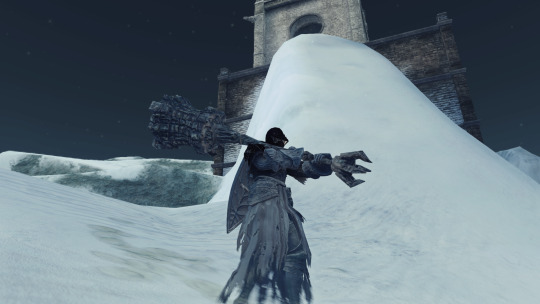
With the Boletarian Palace, Demon’s Souls set the standard for me where fortressed layouts in the series are concerned. At the risk of seeming to treat the Boletarian Palace as a case of insuperable level design, I’m going to quote a few bits here from prior essays concerning it, and hope that it instead demonstrates that its better qualities come from reproducible design decisions:
An uncommon attention was paid to the worlds’ furnishings. One noticed, making their way through [the Boletarian Palace], that rickety palisades were erected on the grand introductory staircase, here and there a discarded carriage with maybe a horse corpse; in small, pocket-like refectories were rows of beds, and tables bearing cups, candelabras, and bowled edibles; outside of these cells were carts harboring casks of wine and buckets; or that on a long wall-walk was a somber parade of trebuchets, and adjacent to this was an attic for carts loaded with to-be-launched boulders. There was a sense that everything was in its right place, and to weave through these environments was to experience a world that innately lent itself to textured terms of engagement. Running up a series of staircases peppered by barrels full of explosive powder, and haunted by torch-wielding madmen, meant grappling with an incendiary challenge, yet the challenge was holistically ingrained in the objecthood of that world. In that way, spatial dealings, navigational or combative, acquired a flavor of believability.
Additionally, Demon’s Souls ran counter to an extant strain of design in action-adventure games that draws a distinguishing line between “combative spaces” and “non-combative spaces.” The least gratifying cases of this strain induce a monotonous awareness of compartmentalization, of there being a manner of space for fights — most often resembling an arena accommodating the spectacle of performance (God of War and its progeny come to mind) — and a manner of space for sites between fights. What made Demon’s Souls a categorical outlier was that conflict could happen anywhere; and that, when conflict did happen, the architecture supplemented it.
. . . the Boletarian Palace’s magic was that its architecture discretely realized and blended the inherent themes of defense, housing, and storage. It both came across as a convincing place (again, “convincing” or “realistic” does not mean that the subject has a 1:1 ratio with reality) and engaged the player with design permutations that took hold of the surroundings, like groups of crossbow-firing soldiers blocking the way on a bridge, or darkly spear-throwing creatures in a dim room meant for storing carriages.
Rather than a stony maze with apposite ornaments thrown in, the Boletarian Palace felt like a castle first and foremost, with encounter design that naturally tapped into its abundance of nooks, sharp angles, and verticalities.
If we’re looking at Eleum Loyce -- which can be more or less separated into a fortified area, a residential zone, and a subterranean network -- I think the pervasive problem is that practically none of it has any suggestive power. Suggestive power is a consequence of the level design per se and the clothing it wears. So when nearly all there is to see is the most spartan of stonework (and not even skillfully texture-mapped stonework) and white mounds, engaging level design is vital. Most of the interiors have been reduced to bare, non-functional cubes, and exteriors largely are bluntly laid out paths where you pick off a line of enemies one by one, sometimes including peripheral retainers. It all has the flavor of a beta zone for developmental testing, and it feels terribly wrong that perhaps the sole memorable detail is a frozen fountain early on.
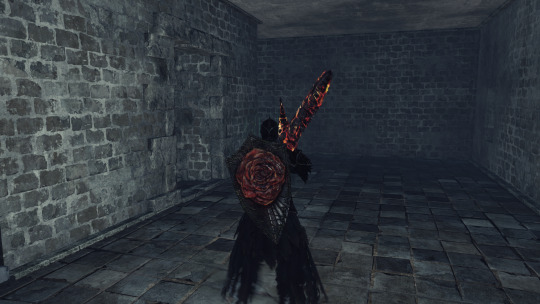

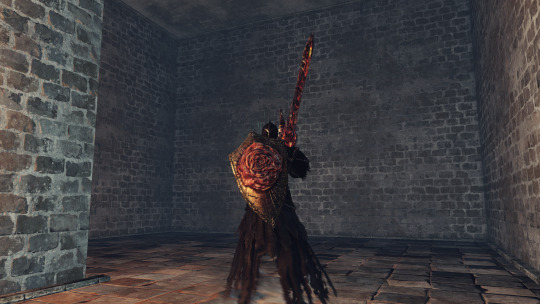

Since this doesn’t really lend itself to interesting encounter design -- there is no ambiguity or mystery to the space, no way to treat it as anything other than a sequence of immediately explicable containers -- and the majority of enemies are super-sturdy soldiers coming in a few flavors, many combative interactions play out as the melee-oriented player leading an alerted bunch of foes to a chokepoint and picking them off with strong attacks. For as much as I could criticize the aesthetic fumbles of the prior two DLC installments, their layouts had definite dynamics: Shulva’s staggered array of towers (some manipulatable), and Brume Tower’s tiered floors skirting circular shafts.
They also featured neat miniature gimmicks that could be engaged to lessen the danger of a given area: destroying sarcophagi in the Dragon Sanctum to make the ghostly sanctum knights assume a corporeal, and practically pregnable, form, and collapsing Ashen Idols speckling the Tower to halt the healing and reappearance of adjacent enemies. It’s hard to really say what Loyce’s comparable gimmicks are. There are, for a while, snowy winds blasting around the fort’s exteriors, but these winds only have a remarkable effect on your range of sight in the optional (and much-hated) Frozen Outskirts (this is, in fact, one of the Outskirts’ few virtues). There are also coats of ice making certain chests inaccessible, but once they’re shattered upon talking to a Lore-Dispensing Character it simply is a matter of backtracking and opening them up in a classically obsessive-compulsive manner (more interesting would’ve been the option to melt the ice by using pyromanic spells).
What little conspicuous level design exists in Eleum Loyce does stand out on its own terms. When you come upon the abandoned residential zone, you must navigate several columned arcades, being careful about the obscured, spine-backed ice rats and, a level above, a spell-casting witchtree spirit or two. Between this triangulation of elements you’ll find yourself using the arcades for cover while also trying to not let their dense arrangement hinder your movements or attacks. It’s basic stuff, and brief, and it’s good (it gets even better when you’re invaded by a black phantom NPC) -- it works on a level beyond shoveling baddies into crates and along straight paths. You’re conscious of an architecture. Disappointing, then, to find that the knotty little complex of residences is really a paltry couple of empty boxes with a useable staircase in one. So much for expanding on that aspect of the city.

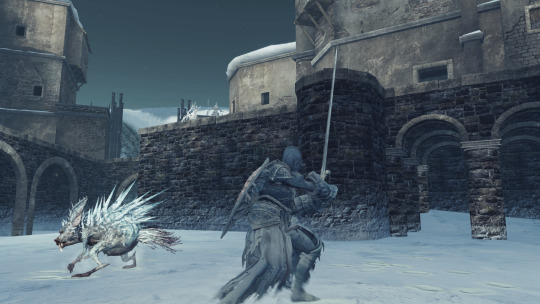
Another similarly brief moment happens later on inside a dim, high-ceilinged hall separated by three floors built of wooden planks. The first of these floors is the most interesting. On it, you’ll juggle seeking shelter from two spell-casters by emerging onto nearby balconies, and taking care of a soldier on each balcony itself before you’re ganged up on by pursuers from the hall; and once you’re back in the hall to take of whoever remains, you’ll have to mind the several holes which break up the wooden flooring and lead to deadly drops. As with many cases of fine level design in the series, it demonstrates how an engaging sense of pressure can be exerted on players by aligning simple, but not overly simple, architecture with complementary enemy positions.
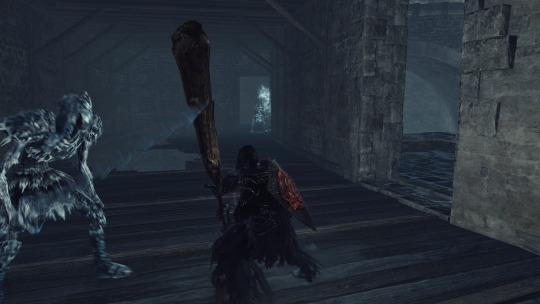

Eleum Loyce has been commended for having several loop-around shortcuts that lead you back to prior locations. These commendations haven’t taken into account why this series-trope has excelled when it has excelled, though. To be sure, Eleum Loyce’s shortcuts function as any shortcut should: they expedite the process of repeat attempts at navigation and impart a sense of incremental progress. But beyond this there’s not really any epiphanic or retrospective spark to the loop-arounds. Eleum Loyce’s overall layout is so diffuse and architecturally generalized -- if you compare the two screenshots below you’ll see how visually similar the city’s explorable portions are to its unexplorable portions -- that you’re never learning about its organizational character or seeing charismatic structures reappear. You’re just opening a door or taking an elevator. And, you know, that’s fine. But it doesn’t warrant special praise.
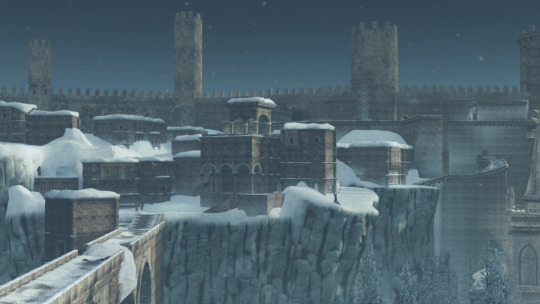
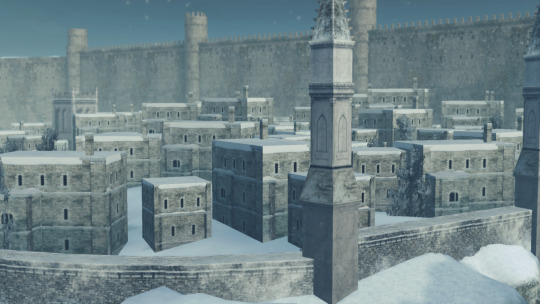
And then there’s the unpleasant friction of the Frozen Outskirt’s conceptual strength versus its actual strength. As each DLC installment has had mechanical gimmicks (some, uh, ostensible), each has also had an optional gauntlet catering to multiplayer efforts. These have been pretty uniformly terrible -- I called Shulva’s an “utterly reduced ‘path with enemies’” -- and are solely concerned with throwing as much densely packed shit at the player(s) in the tightest possible, and least imaginatively suggestive, spaces. As I wrote in the same essay, “There is no design goal here except, ‘Swamp the player who should have assistance to divide the streams of projectiles and the soldiers' advances.’” A slight exception, the Frozen Outskirts offer the novel idea of dislocating players by having the snowdrifts oscillate between visibility and near-invisibility by way of periodic snowstorms. If this were left on its own, if the challenge were one of pure navigation -- having to find one’s bearings and using several ruinous sites as guideposts, and fighting or running away from a few hostile adventurers -- I really think the Frozen Outskirts would be great. All of this potential is squandered by tossing what essentially amount to mini-bosses at players, with no options for even the tiniest bit of cover among the stretches separating the ruins (recalling Elana’s chief design failure), and so the overall experience is demoted to that of a frustrating slog.
I think what makes Eleum Loyce the series’ low-point for me is its formal vapidness + its very positive reception. I feel bored and alienated. It’s hard to not think that people have been poisoned to believe that what is most remarkable about these games is the element of challenge. Eleum Loyce is, to me, a snubbing of everything I’ve enjoyed about exploring these games’ places. All curious details have been scrubbed out and what remains is a base obstacle course of cartoonishly themed enemies -- ice-coated soldiers, some with crystals bursting from their backs -- with the ultimate signifier of Prepare to Die challenge at the end: a bunch of knights in a huge arena protecting an even bigger knight, who epically emerges from Barad-dûr’s peak to a tritone and can make his sword be the biggest sword.
Anyway. That’s what I think. What do you think?
15 notes
·
View notes
Text
Essential Avengers: Avengers #161: Beware the Ant-Man!
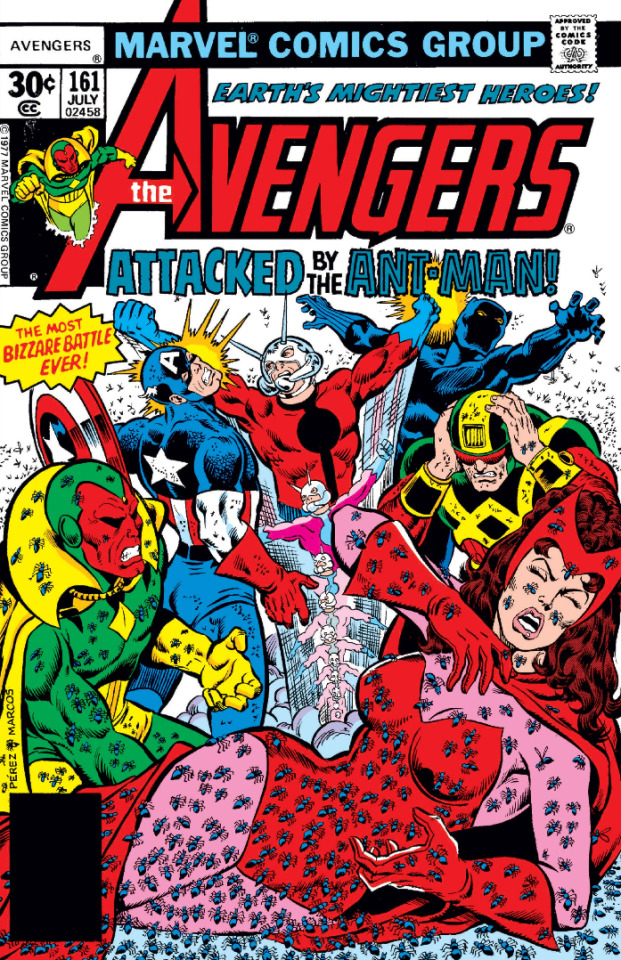
July, 1977
There’s just so much here.
I almost don’t want to talk about it. It glistens like a soap bubble and I’m afraid it will pop if I try to grasp it.
What I will say is this: the title and the poses of angry agony (angrony?) remind me very much of those Man’s Life magazine covers. The ones where shirtless men have knife fights with nature?
Also, I don’t know what Scarlet Witch is up to. It almost seems like she’s trying to pose sensuously but also is being bitten by countless ants. But is trying to make it work.
Anyway, take a moment to enjoy or be baffled by this cover while I get things started over here.
We start bewaring the Ant-Man with a nice splash panel seen from inside a panel as Ant-Man peeps in on some weirdos intruding in Tony Stark’s mansion.

Wait. I recognize these weirdos. I’d recognize Wanda’s inexplicable hair and Iron Tony’s incredible bossy way of pointing anywhere.
But they are weirdos.
For example, they’re all standing around admiring Wonder Man’s latest travesty of fashion. He had to get new threads after his jerkass brother shredded his old costume.
The Beast designed it for him.

And its easy to mock. I do it twice a week. But keep in mind that Beast only wears shorts. And before that I think Professor X dressed him. So. Yeah. He’s. Not great at designing new costumes.
And Wonder Man has been dead and dressed like an idiot for years so we can forgive him for not knowing any better.
But I’m very slightly surprised at you, Wanda. Don’t enable this.
Wonder Man’s turn on the figurative catwalk is cut short as a tiny voice demands Iron Man’s attention. If he really is Iron Man.

Of course its Ant-Man and he’s here for the first official meeting of the Avengers (haha whaaaaat?) but he doesn’t recognize all these strangers. Except Captain America but everybody knows Captain America is dead. And also, where are Hulk and Thor? And whats the deal with changing out of your golden armor?
So either this is a bad imposter or Hank Pym was rebooted all the way back to the time of Avengers #1. And I can’t go back to that overly controlling Hank, I just can’t.
When the ‘strangers’ don’t immediately fall over themselves to explain everything to him, Ant-Man immediately leaps to attack with the greatest power of all: a ludicrous number of ants.
So he has a swarm fly right into Iron Man’s mask through the eye slits and god that is just a nightmare. Biting his eyes and whatnot.

And then he launches himself right at Cap’s chin to play him some chin music. By punching him. That’s what you get for identity theft, friend!
Wanda is distracted by oh god ants ants everywhere crawling all over ahhhhhhhhhhhhhhh so she can’t bring her vague powers to bear. And there’s so many tiny things flying around that Wonder Man can’t keep track of Ant-Man. At least he, Wonder Man, is personally safe from any and all things that Ant-Man could do.
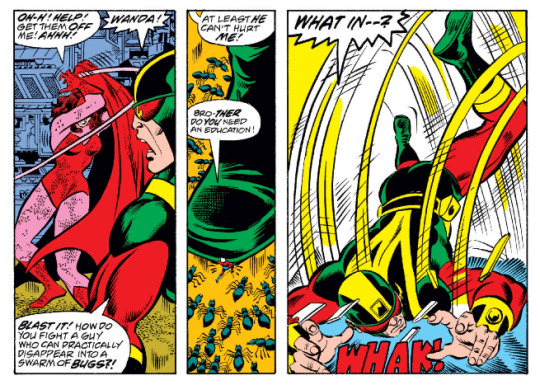
Womp womp.
Meanwhile, in the records room, Beast was brushing up on all Avengers history. Because you gotta do your homework. Especially if it prevents him from being uninformed when some asshole from the Avengers’ past like Grim Reaper pops up again.
But Black Panther hears something so he and Beast go to investigate.
And immediately get KO’d by Ant-Man doing a growing double shoryuken.

Because apparently growth physics works thusly: you can add your momentum from a grow or shrink to add oomph to an attack. I think its sometimes called Shrink Fu.
I know people mock shrinking heroes and in-universe Hank Pym has a lot of insecurity about his role on the Avengers (Wasp never seems to have problems. She just loves Wasping, all the Wasp time).
And Ant-Man, Yellowjacket, Wasp, whathaveyou are often played up as ineffectual.
But looking here at this fight, its clear that ants is a great power and that shrinking can be used effectively.
By writer fiat. But usually its not, also by writer fiat.
The writers go through all these permutations and changes for Hank Pym to try to make him interesting when they could just write him better.
And for that matter, Wasp. There’s no reason she shouldn’t be able to pull off just this kind of effectiveness but with also bio-electricity blasts and flying.
Just write your damn characters better, Avengers writers. If you put a person on the team, let them be effective.
Anyway.
Vision is a little better off. He went partially intangible so he can’t be hurt and the ants that intersect his body get shocked. So he’s untouchable but he can’t help anyone. Because he’s untouchable.
He especially can’t help Wanda who is experiencing the agony of the ant pile. There’s just so many ants. Just so, so many.
Why don’t the Avengers have a chemical safety shower or anything? Why aren’t they trying to do anything??
But suddenly Wasp flies in to save the day. As Ant-Man Hank has no counter to her Wasp’s sting, like Yellowjacket’s disruptor gun. So she just blats him off Anthony.

Ant-Hank plummets toward the ground but thankfully, Wonder Man catches him.
Which. I mean. At such a tiny mass, the fall should have been nothing. But if it was something, then hitting Wonder Man’s supertough skin slightly higher than the floor is hardly better.
But the comic treats it as saving him from a potentially dangerous fall so lets just roll with it.
Tiny Wasp activates some gas canisters to grow Hank back to full size because I guess in addition to a pill and serum, Pym particles also come in aerosol sprays.
And with Hank full sized unconscious in Wonder Man’s arms, Wasp unshrinks and-
Oh god.
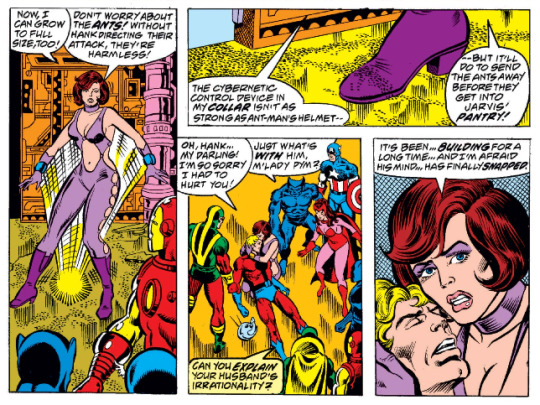
Is that her new costume? That is terrible.
I know Wanda calls Jan the Avengers’ fashion expert but she has a lot more misses than hits. And also more outfits than possibly any other superhero? Or near the top of the list at least.
I guess today is just a day for bad new outfits.
So Wasp unshrinks and commands Ant-Man’s ant swarms to leave the mansion. She didn’t do it earlier because her ant control collar isn’t as strong as Ant-Man’s helmet. It is bigger. And shinier.
And now its time for Wasp to Explain It All.
So here’s a bit of old news: Hank Pym is not the most emotionally stable individual out there.
And his constant parade of identities maybe was a warning sign?
And at home, more and more of his projects were ending in failure, causing Hank to lash out in rage and frustration and smash his shit. Maybe this is also somewhat of a red flag.
And Hank is the type that feels emasculated that he’s living off his wife’s inheritance. And would be salty as hell if Jan offered to pay for him to see a psychiatrist.
So she just went to go see a psychiatrist on his behalf without telling him.
I’m not sure the kind of helpfulness you can expect from second-hand psychiatry advice but telling her to reinforce his positive behavior and convince him to rejoin the Avengers seemed to work.
He was acting like the Hank she remember, especially at home. Wink.
... She politely implies their healthy sex life right at the Avengers.
Anyway, when Hank and Jan flew off to improve his their powers at the beginning of last issue, something strange happened.
Hank just clammed up and flew away from her.
Figuring that he had moodily relapsed, Jan went home and designed a new outfit to ‘keep his interest’ and-

Oh god that’s not a superhero outfit, that’s a bedroom activity outfit!
I’m not.... entirely sure why a sexy outfit needs an ant-controlling collar but I already know far more about Wasp and Hank’s sex life than I want to.
I guess it says something that lingerie and a superhero outfit could be easily confused for each other but its not anything that hasn’t been said before.
So.
Moving on.
When Jan went to go get Hank, she found his lab destroyed and him missing. Because Hank Pym.
It was finally too much to face alone so she flew to get help and just so happened to help them instead.
And Jan wonders whether its too late to help Hank.
NONSENSE, expresses the Avengers.
Iron Man decides what they need to do is strap him into the pain-o-tron, er, I mean the subliminal recall-inducer. Y’know, that device that makes people recall things by hurting them a lot?
They’ll restore Hank’s memories that way, since he seems to have blanked everything since the very first day of the Avengers, for some reason.
Meanwhile, Beast will drive Wasp home to pick up some things to help jog Hank’s memory.
Beast, the Other Hank, agrees in his usual flippant clownery way, but Cap and Iron Man both yell at him for his inane antics at a time like this.
He sheepishly apologizes to Jan. Later, as Beast drives Jan to her house, she tries to say that his joking around didn’t matter. But Beast interrupts her.


Beast: “Mrs. Pym, it’s... hard to be a Beast... sometimes.”
An admission that a lot of Beast’s foolery is sad clowning. Goofing to hide and distract from his own insecurities and troubles.
Maybe Cap and Iron Man should be more understanding, really. Anyway, Beast is now in a mood.
He stays in the car when Jan goes inside because he doesn’t want to “upset” the neighbors with his appearance. And he thinks to himself how lucky Other Other Hank (Pym) is that he has a wife like Jan, “a lot luckier than a Beast could ever be!”
Meanwhile, Jan is thinking some sad thoughts herself.
Apparently Hank called the new house Jan’s “palace” because Hank Pym. But Jan wanted it to be their palace. And she resolves that if she gets her Hank back, she’ll never let something as stupid as money get between them again.
I’m not sure how she’ll manage that. Is she going to stop paying for the house and all his lab equipment and basically completely financing him?
Oh. And then Jan sees someone off-panel and yells “No! Not... you!”
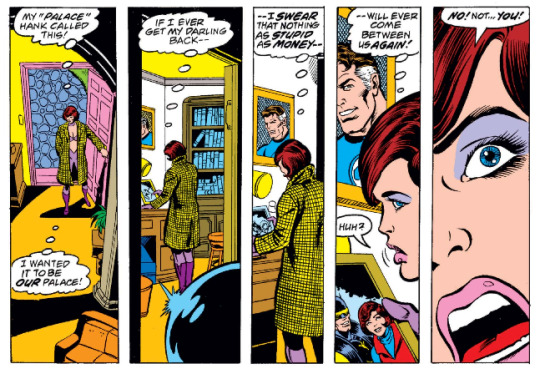
Is it more ants? Don’t touch that nonexistent dial!
Back at the mansion, they’ve turned the pain-o-tron up to intolerable levels to no effect.
I guess subjecting a man to an alarming amount of pain just won’t cure amnesia.
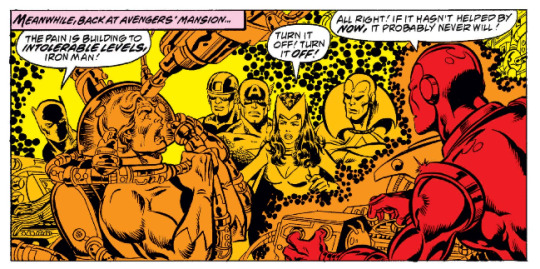
...
HAS THE SUBLIMINAL RECALL-INDUCER EVER WORKED?!
Did... did Tony just build a torture chair and then play it off as something else when Cap asked him what it was?
Anyway, since pain didn’t work, the Avengers decide maybe surrounding Hank Pym with his oldest and closest friends will.
WHY DIDN’T THEY TRY THAT FIRST??
What kind of perspective does someone bring into a situation where unbearable levels of pain is the first resort to help a friend?
Alas, however, Thor is out of reach. Quicksilver is dealing with his own shit what with Attilan having blown up. And Hawkeye?
We get a full page detailing what he’s up to, for some reason.
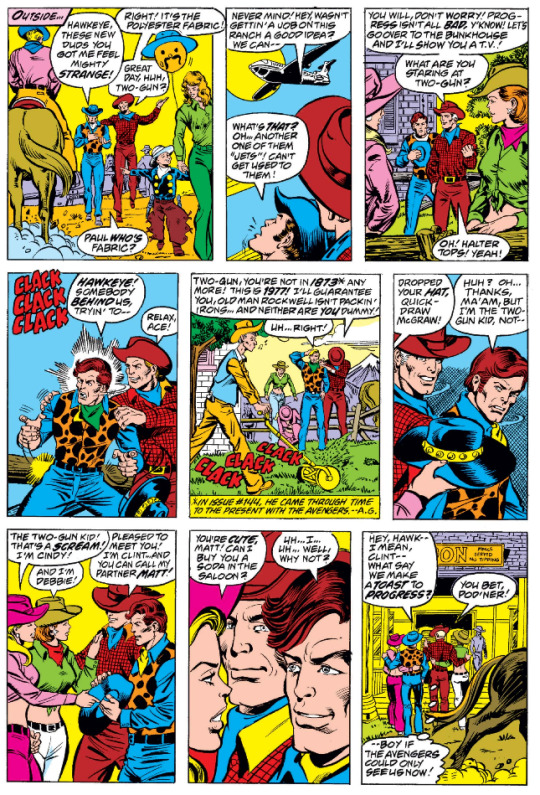
He and Two-Gun Kid are working at the Cheery-O’s Dude Ranch. Hawkeye is helping Two-Gun deal with culture clash through a shared interest in flirting with cowgirls.
I don’t know why this.
I just know that Hawkeye is real proud of himself, thinking “boy if the Avengers could only see us now!” because yeah, they’d be sooo impressed, Hawkeye.
So the Avengers stand around a dazed and confused Hank Pym waiting for any callbacks when suddenly Beast limps into the room muttering:
Beast: “guys... he got... Jan! he’s coming... oh-h-h!”
And then the ceiling explodes.

BECAUSE ULTRON.
He never uses the front door.
And he mocks the Avengers for being startled that he’s not dead. After all, haven’t Captain America, Wonder Man, and Vision come back from seeming death?
But he also explains how he’s back. Because I guess he wants the Avengers to applaud his forethought.
See, Ultron had Charm’d Person several pawns to recreate him on the off chance that he was destroyed by an actual toddler.
That’s just the kind of guy Ultron is. Always planning those contingencies.
Vision charges forward to stop him again and again and keep stopping him until stopping him stops failing.
But Ultron prepared a series of win buttons before launching his attack.
For example: he knows every detail of Vision’s construction so he created a weapon in his silly head antenna just for Vision.
And although Vision tries to diamond hard tank it, it is for naught. And he collapses.

And then Iron Man, Black Panther, and a hesitant Wonder Man charge forward on Cap’s AVENGERS -- ATTACK! command.
So Ultron uses EXPLODE and its super effective.
Iron Man is the first to recover his feet, protected by his armor. And he charges Ultron to... try to strangle him? I’m not really sure what Tony was planning here.
And it was dumb. Because Ultron built power siphons into his suit to drain Iron Man’s armor. And the powerless armored Avenger collapses into a heap at Ultron’s feet.
Oh and then he headshots Beast and Wonder Man with the encephalo-ray, knocking them out.
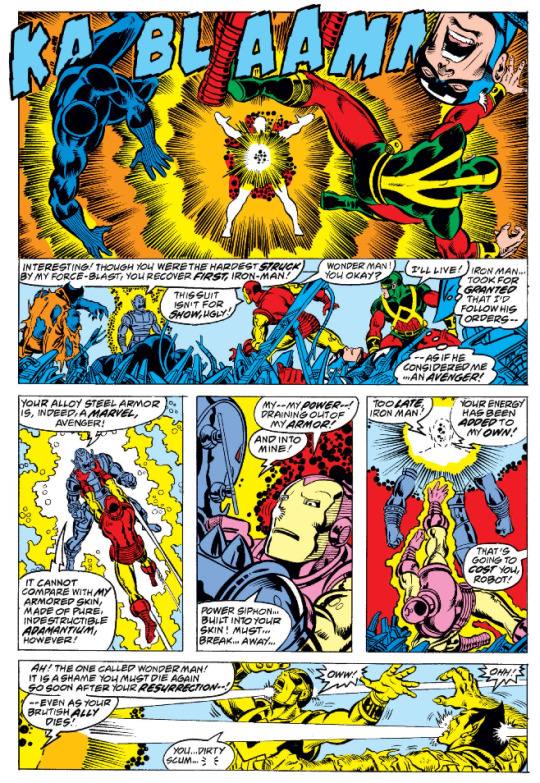
Ultron marvels that it took almost two entire seconds for Wonder Man to fall before the win button encephalo-ray. Truly unfortunate that the Grim Reaper failed to keep up his bargain because Ultron would so have loved an interesting study subject such as Wonder Man.
Okay but while Ultron was talking to himself, Scarlet Witch has been aligning her chakras or waving her fingers or whatever it is that she has to do to psyche herself up. Shaking off the oh god so many ant bites maybe.
And not without cause, she declares herself the most dangerous threat Ultron will ever face.
Red witch versuuuus robot. RED WITCH HATE TECHNOLOGY ROBOT HATE THE RED WITCH THEY WILL FIGHT ETERNALLY
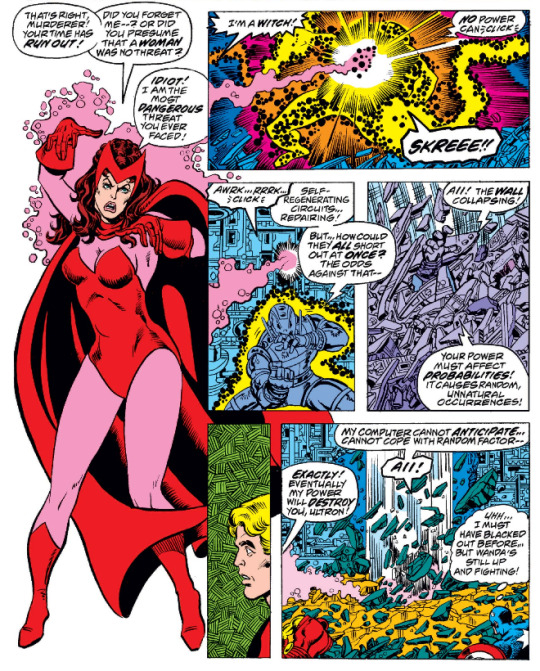
Also, magic is super effective against Ultron.
And sure, Wanda’s powers have been vague lately. Her power up from training with Agatha Harkness seems mostly forgotten and she’s back to probability alteration. But she makes it work here.
Because that pink wavely energy just made all of Ultron’s circuits short out at the same time. What are the odds??
And then a wall falls on him.
And then the ceiling falls on him.
Ultron deduces that Scarlet Witch’s powers affect probabilities to create random, unnatural occurrences but its very nature as a random factor means that Ultron cannot anticipate or cope with it.
Eventually, Wanda’s power will destroy Ultron.
And then Cap ruins everything.
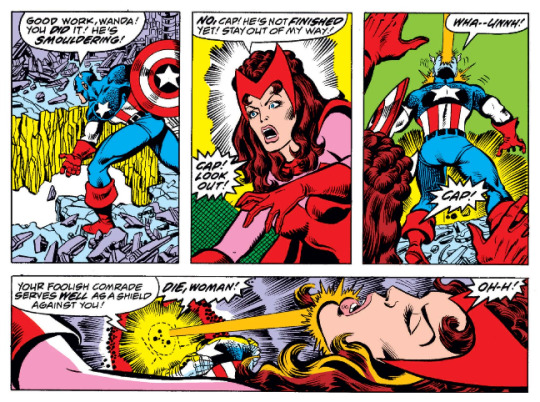
He prematurely decides Ultron is defeated and gets between Scarlet Witch and Ultron. Bam. The encephalo-ray strikes down Cap. And then Ultron uses Cap’s body as a shield. Bam. Scarlet Wanda is encephalo’d.
Dammit, Cap.
Now the Avengers are all down.
ktang.
Except the Ant-Man. He doesn’t know who this robot is but he feels just so compelled to fight him. Like... he’s got a real punchable face or something.
And as he bounces all around tiny size throwing tiny rocks at Ultron, Ultron uses his vacuum finger to suck him up.

Because of course Ultron has a vacuum finger. Imagine thinking that Ultron didn’t have a vacuum finger.
And... apparently Hank Pym is what Ultron was here for.
Very conscientious of saving the planet but more a dramatic little shit, Ultron turns the lights off as he leaves, also metaphorically symbolizing that darkness has fallen on the era of the Avengers.
And then he smashes a NEW hole through the ceiling and flies off into the night.
Later...
Jarvis comes back with groceries to find the lab is a mess, there’s holes in the floor and ceiling and dead Avengers everywhere. He’s a butler for godsake, not a maid.
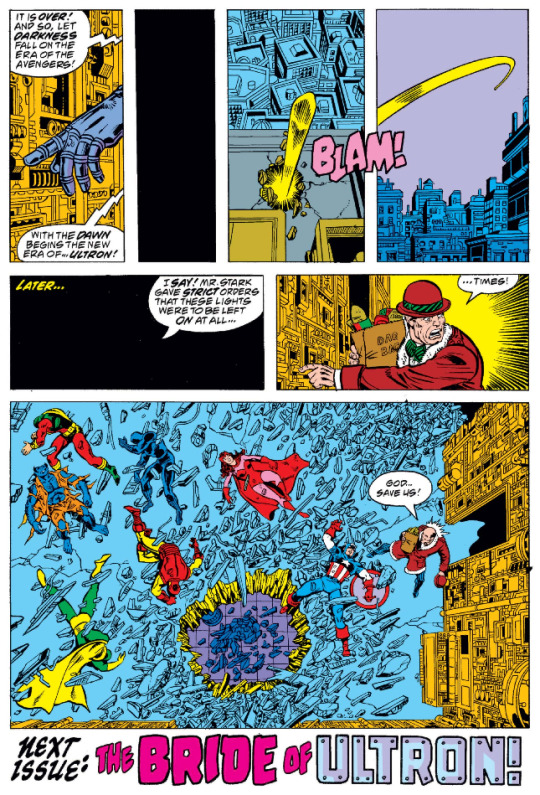
Okay but seriously, he’s horrified.
But facetiously, this is like the fourth supervillain home invasion in a week. He has to be a little bit jaded to it by this point.
Anyway, next time: Bride of Ultron BECAUSE WHY NOT??
My real question is when do we get Son of the Return of Ultron’s Revenge?
#Avengers#Ant Man#Ultron#Scarlet Witch#the Vision#Captain America#Iron Man#the Wasp#Beast#Black Panther#Wonder Man#Essential Avengers#Essential marvel liveblogging#Marvel two in one ie two stomps in one issue#here's a thing though#Wasp and Wanda got to be the MVPs this time#that almost never happens at the same time#ants is one of the great powers
27 notes
·
View notes